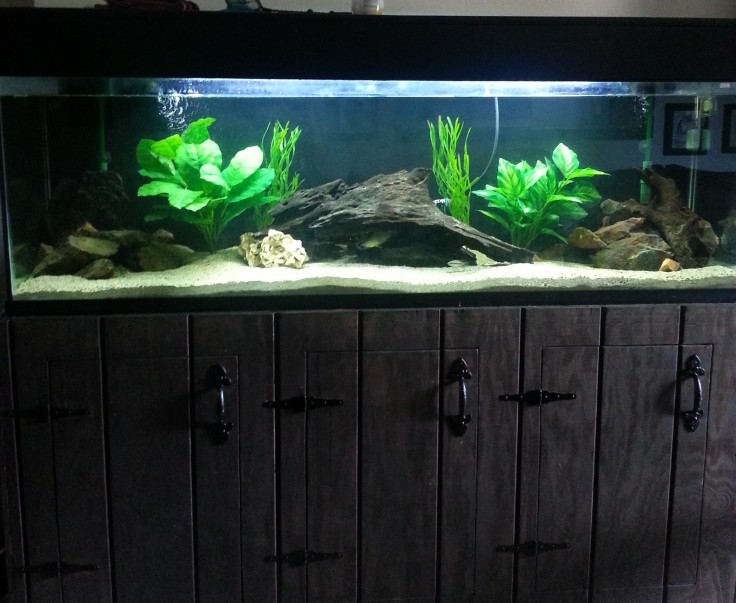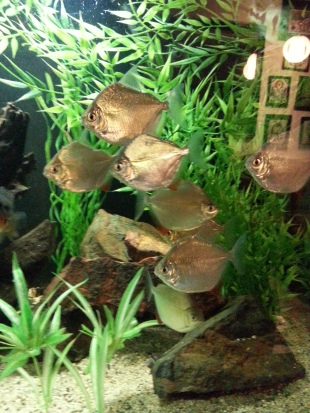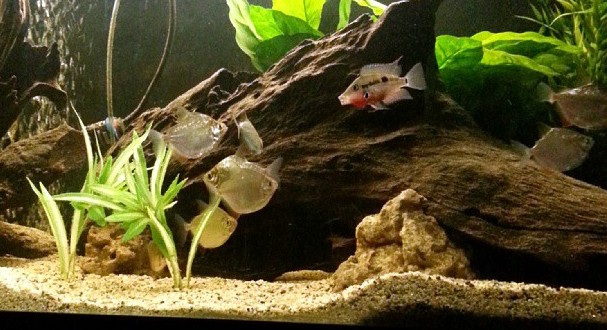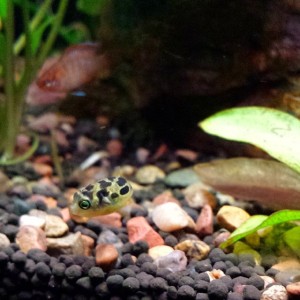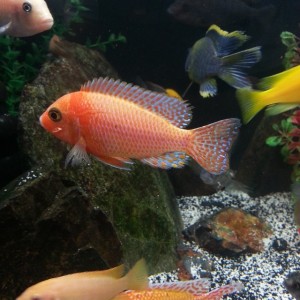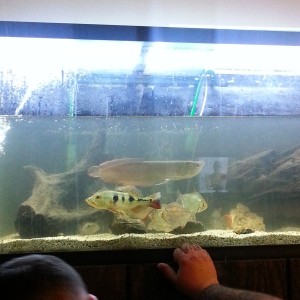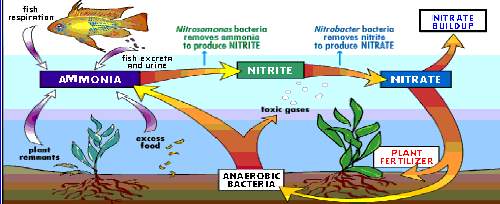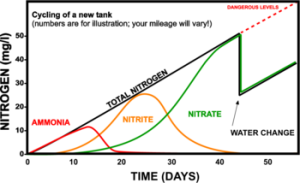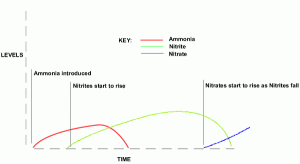Arowana
Asian Arowana
Jardini Arowana
Silver Arowana
Asian Arowana
Scleropages formosus
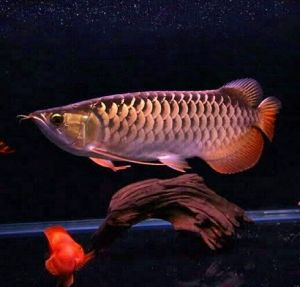
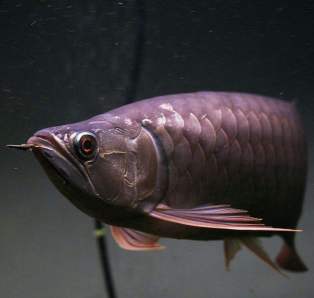
Difficulty: 3/5
Tank minimum: 240 gallon
Water parameters: 75F-85F, PH 6.5-7.5
Maximum size: 36″
Tank region: Top dwelling
Behavior: Aggressive
Diet: Carnivore based. Diet can be include floating carnivore pellet, frozen or live foods such as shrimp, mussels, white fish, worms, frogs, insects. Juveniles essentially would appreciate crickets in their diet.
Compatibility: Best kept solo, but occasionally be kept with large robust fish, possibly large catfish
Extra: This desirable fish is illegal to keep in the United States. However, along with it’s undeniable beauty comes a very hefty pricetag where they are legal to own.
While many may be tempted to keep this dragon fish in their aquariums, I would not recommend keeping one unless you plan to accommodate this tankbuster’s needs long term. The arowana is supposed to ward off evil spirits and they have been known to “sacrifice” themselves for their owners by jumping out of the water. For this reason, it is extremely important to have a very secure lid. This tale probably stems from the fact that arowana leap out of the water either for food or because they can be quite jumpy. For this jumpiness, it is also recommended to keep the water level slightly lower since the arowana is known for spooking and slamming the lid.
Jardini Arowana
Scleropages Jardini
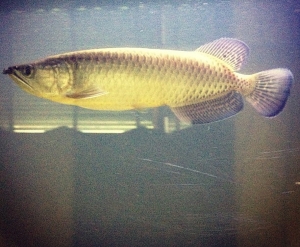
Difficulty: 3/5
Tank minimum: 180 gallon long
Water parameters:
Maximum size: 24″
Tank region: Top dwelling
Behavior: Aggressive
Diet: Carnivore based. Diet can be include floating carnivore pellet, frozen or live foods such as shrimp, mussels, white fish, worms, insects. Juveniles essentially would appreciate crickets in their diet.
Compatibility: Best kept solo, but occasionally be kept with large robust fish, possibly large catfish
Extra: This Australian arowana is is a much smaller and more manageable size than it’s relative the silver arowana. However, as it gets large it can become quite aggressive in nature. While you may be able to start with tankmates, usually the jardini will end up needing to be a solo fish.
While many may be tempted to keep this dragon fish in their aquariums, I would not recommend keeping one unless you plan to accommodate this tankbuster’s needs long term. The arowana is supposed to ward off evil spirits and they have been known to “sacrifice” themselves for their owners by jumping out of the water. For this reason, it is extremely important to have a very secure lid. This tale probably stems from the fact that arowana leap out of the water either for food or because they can be quite jumpy. For this jumpiness, it is also recommended to keep the water level slightly lower since the arowana is known for spooking and slamming the lid.
Silver Arowana
Osteoglossum bicirrhosum
Difficulty: 3/5
Tank minimum: 300 gallon long
Water parameters: 75F-82F, PH 6.0-7.5
Maximum size: 4′
Tank region: Top dwelling
Behavior: Predatory
Diet: Carnivore based. Diet can be include floating carnivore pellet, frozen or live foods such as shrimp, mussels, white fish, worms, insects. Juveniles essentially would appreciate crickets in their diet.
Compatibility: Other large fish that can’t be eaten. Avoid overly aggressive tankmates.
Extra: The silver arowana is the most common of the arowana seen in the trade. It is also one of the largest. While many may be tempted to keep this dragon fish in their aquariums, I would not recommend keeping one unless you plan to accommodate this tankbuster’s needs long term. The arowana is supposed to ward off evil spirits and they have been known to “sacrifice” themselves for their owners by jumping out of the water. For this reason, it is extremely important to have a very secure lid. This tale probably stems from the fact that arowana leap out of the water either for food or because they can be quite jumpy. For this jumpiness, it is also recommended to keep the water level slightly lower since the arowana is known for spooking and slamming the lid.

While most arowana have the possibility of drop eye, the silver arowana for whatever reason tends to be the most susceptible to this. Drop eye is the condition where fatty tissue starts to form above the eye giving it the appearance that the eye is looking downwards. It can occur in any eye, and the severity is ranging. The real cause of this remains unknown, but many speculate that it can be caused by a fatty diet, injury, the arowana looking unnaturally downwards too often, or genetics. I suspect this has more to do with genetics than anything since the silver arowana tends to be the most susceptible even though all the species are exposed to the same risks. A proper diet, proper accommodations, and possibly a ping pong ball to direct the arowana’s attention upwards are always recommended regardless.
Back to the top
Catfish
Redtail Catfish
Ripsaw Catfish
Shovelnose Catfish
Redtail Catfish
Phractocephalus hemioliopterus
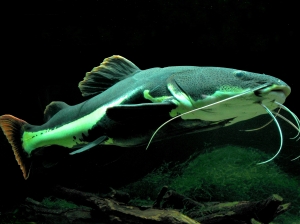
Difficulty: 3/5
Tank minimum: 300 gallon+
Water parameters: 70F-80F, PH 5.5-7.5
Maximum size: 48″
Tank region: Bottom dwelling
Behavior: Predatory
Diet: Carnivore based diet. Will accept most foods which should include a carnivore based pellet and meaty foods such as fish, worms, crustaceans, etc.
Compatibility: Other large fish at a minimum of 1 foot in length
Extra: Though widely available, it is actually quite unsuitable for the majority of most hobbyists. This active 4 foot beast can get up to 95 pounds; that’s the size of a big Alaskan Malamute! While they may work in a 300 gallon tank, they are really best suited for ponds over 1,000 gallons. So before you are tempted to add the cute baby redtail to your aquarium, be prepared for this baby to QUICKLY outgrow most tanks and many fish stores will not take this species back. Like most catfish, this species can be sensitive to certain medications.
Back to the top
Ripsaw Catfish
Oxydoras niger
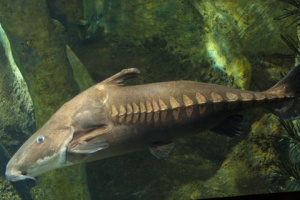
Difficulty: 3/5
Tank minimum: 200 gallon+
Water parameters: 70F-81F, PH 6.0-7.8
Maximum size: 35″
Tank region: Bottom dwelling
Behavior: Predatory, though relatively peaceful as long as it has enough space to have as territory
Diet: Carnivore based diet. Will accept most foods which should include a carnivore based pellet and meaty foods such as fish, worms, crustaceans, etc.
Compatibility: Tankmates over 6″ in length, avoid overly boisterous fish that may harass this fish.
Extra: Also known as the Niger Catfish, the Ripsaw Catfish is one of the larger species of catfish in the hobby. While not as large as the RTC, this tankbuster requires a very large aquarium and may not be suitable for most hobbyists. They can be housed in a 200 gallon minimum, though larger is much more ideal. Like most catfish, this species can be sensitive to certain medications.
Back to the top
Shovelnose Catfish
Phseudoplatystoma sp.

Difficulty: 3/5
Tank minimum: 200 gallon
Water parameters: 72F-80F, PH 6.0-7.5
Maximum size: 24″+
Tank region: Bottom dwelling
Behavior: Predatory
Diet: Carnivore based diet of fish, crustacean, worms, mussel, etc. Can be trained to take carnivore pellets
Compatibility: Larger species that aren’t overly aggressive. Avoid skittish tankmates that can spook this fish
Extra: This striking catfish is another large species of catfish. While it usually reaches around 24″ it can easily grow much larger. They grow extremely fast easily reaching 1.5 feet within the first year. In the wild this fish can reach upwards of 40″. The shovelnose can be sensitive to nitrates, therefore it’s very important to have heavy filtration and regular water changes. Like most catfish, this species can be sensitive to certain medications.
Back to the top
Cichlid, Lake Malawi
Aulonocara Baenschi “Sunshine Peacock”
Aulonocara Jacobfreibergi “Eureka Peacock”
Aulonocara Maylandi “Sulfur Head Peacock”
Aulonocara Stuartgranti”Blue Regal Peacock”
Copadichromis Borleyi “Kadango”
Cyrtocara Moorii “Blue Dolphin”
Dimidiochromis Compressiceps “Malawi Eye Biter”
Labidochromis Caeruleus “Electric Yellow Lab”
Maylandia lombardoi “Kenyi”
Melanochromis Auratus
Metriaclima Callainos “Blue Cobalt Zebra”
Metriaclima Estherae “Red Zebra”
Metriaclima Greshakei “Ice Blue Zebra”
Nimbochromis Livingstonii “Livingstoni”
Nimbochromis Venustus “Venustus”
Protomelas sp. “Steveni Taiwan” (Taiwan Reef)
Pseudotropheus Crabro “Bumblebee”
Pseudotropheus Demasoni “Demasoni”
Aulonocara Baenschi
“Sunshine Peacock”
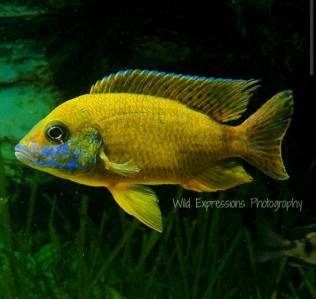
Difficulty: 2/5
Tank minimum: 55 gallon
Water parameters: 73F-84F, PH 7.8-8.6, GH
Maximum size: 6″
Tank region: All over
Behavior: Mildly Aggressive
Diet: Omnivore based. High quality pellet or flake, frozen or live foods such as bloodworms, daphnia, brine, and other invertebrates. Avoid tubifex and beef heart.
Compatibility: Other Malawi species of similar size and temperament. The overly aggressive Mbuna may not be suitable tankmates.
Extra: The sunshine peacock is a wonderful addition to adding color to an African cichlid tank. The sunshine can reach up to 6″ but are closer to 4″-6″. Peacocks are one of the more mild mannered species to choose from, but use caution when housing two males together. It is recommended to have at least 100 gallons when housing two males of the same species.
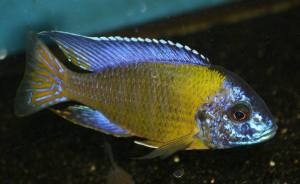
Some hobbyists use the ratio 6:1 with 6 females to 1 male, some choose 2:1, while others will simply house all males. In my opinion, there is no exact science to finding the right blend. I prefer the slightly overstocked method with lots of rock, hiding, and decorations to break line of sight. By slightly overstocking your tank it will help reduce aggression. It is extremely important to over filtrate and do regular weekly water changes on your African tanks as higher PH can make ammonia more toxic. Overstocking makes it even more imperative to have extra filtration as well. Stay tuned for an article on the art of overstocking.
Aulonocara Jacobfreibergi
“Eureka Peacock”
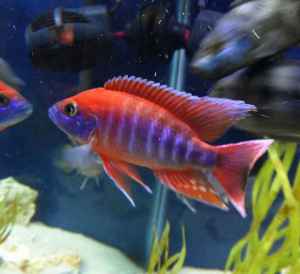
Difficulty: 2/5
Tank minimum: 55 gallon
Water parameters: 73F-84F, PH 7.8-8.6, GH
Maximum size: 8″
Tank region: All over
Behavior: Mildly Aggressive
Diet: Omnivore based. High quality pellet or flake, frozen or live foods such as bloodworms, daphnia, brine, and other invertebrates. Avoid tubifex and beef heart.
Compatibility: Other Malawi species of similar size and temperament. The overly aggressive Mbuna may not be suitable tankmates.
Extra: The Eureka is just one of the different peacocks described under Jacobfreibergi. The Eureka is a natural strain of peacock found in the wild and are usually found around 6″ but can be found as large as 8″. Peacocks are one of the more mild mannered species to choose from, but use caution when housing two males together. It is recommended to have at least 100 gallons when housing two males of the same species.

Some hobbyists use the ratio 6:1 with 6 females to 1 male, some choose 2:1, while others will simply house all males. In my opinion, there is no exact science to finding the right blend. I prefer the slightly overstocked method with lots of rock, hiding, and decorations to break line of sight. By slightly overstocking your tank it will help reduce aggression. It is extremely important to overfiltrate and do regular weekly water changes on your African tanks as higher PH can make ammonia more toxic. Overstocking makes it even more imperative to have extra filtration as well. Stay tuned for an article on the art of overstocking.
Aulonocara Maylandi
“Sulfur Head Peacock”

Difficulty: 2/5
Tank minimum: 55 gallon
Water parameters: 73F-84F, PH 7.8-8.6, GH Hard
Maximum size: 6″
Tank region: All over
Behavior: Mildly Aggressive
Diet: Omnivore based. High quality pellet or flake, frozen or live foods such as bloodworms, daphnia, brine, and other invertebrates. Avoid tubifex and beef heart.
Compatibility: Other Malawi species of similar size and temperament. The overly aggressive Mbuna may not be suitable tankmates.
Extra: The Sulfur Head is a striking species of fish that can be distinguished by the yellow blaze on the top of it’s head and down it’s dorsal on the males. They are usually around 4″-5″ but can get up to 6″. Peacocks are one of the more mild mannered species to choose from, but use caution when housing two males together. It is recommended to have at least 100 gallons when housing two males of the same species.
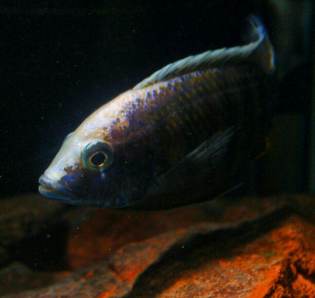
Some hobbyists use the ratio 6:1 with 6 females to 1 male, some choose 2:1, while others will simply house all males. In my opinion, there is no exact science to finding the right blend. I prefer the slightly overstocked method with lots of rock, hiding, and decorations to break line of sight. By slightly overstocking your tank it will help reduce aggression. It is extremely important to overfiltrate and do regular weekly water changes on your African tanks as higher PH can make ammonia more toxic. Overstocking makes it even more imperative to have extra filtration as well. Stay tuned for an article on the art of overstocking.
Aulonocara Stuartgranti

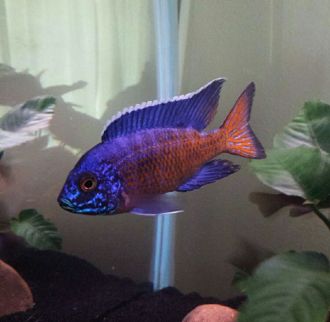
Difficulty: 2/5
Tank minimum: 55 gallon
Water parameters: 73F-84F, PH 7.8-8.6, GH
Maximum size: 5″
Tank region: All over
Behavior: Mildly Aggressive
Diet: Omnivore based. High quality pellet or flake, frozen or live foods such as bloodworms, daphnia, brine, and other invertebrates. Avoid tubifex and beef heart.
Compatibility: Other Malawi species of similar size and temperament. The overly aggressive Mbuna may not be suitable tankmates.
Extra: The Blue Regal and Ngara Flametail are just some of the different peacocks described under Stuartgranti. Peacocks are one of the more mild mannered species to choose from, but use caution when housing two males together. It is recommended to have at least 100 gallons when housing two males of the same species.
Some hobbyists use the ratio 6:1 with 6 females to 1 male, some choose 2:1, while others will simply house all males. In my opinion, there is no exact science to finding the right blend. I prefer the slightly overstocked method with lots of rock, hiding, and decorations to break line of sight. By slightly overstocking your tank it will help reduce aggression. It is extremely important to over filtrate and do regular weekly water changes on your African tanks as higher PH can make ammonia more toxic. Overstocking makes it even more imperative to have extra filtration as well. Stay tuned for an article on the art of overstocking.
Back to the top
Copadichromis Borleyi
“Kadango”

Difficulty: 2/5
Tank minimum: 75 gallon
Water parameters: 73F-82F, PH 7.8-8.6, GH
Maximum size: 7″
Tank region: All over
Behavior: Mildly Aggressive
Diet: Omnivore based. High quality pellet or flake, frozen or live foods such as spirulina, bloodworms, daphnia, brine, plankton, and other invertebrates. Avoid tubifex and beef heart.
Compatibility: Other Malawi species of similar size and temperament. The overly aggressive Mbuna may not be suitable tank mates.
Extra: The Kandango comes in a few different varieties such as the Red Fin, Liuli, and Sambia Reef. Once categorized as Haplochromis, it is now categorized under Copadichromis. Like Haps, it is also considered a more mild mannered rift cichlid.
Some hobbyists use the ratio 6:1 with 6 females to 1 male, some choose 2:1, while others will simply house all males. In my opinion, there is no exact science to finding the right blend. I prefer the slightly overstocked method with lots of rock, hiding, and decorations to break line of sight. By slightly overstocking your tank it will help reduce aggression. It is extremely important to over filtrate and do regular weekly water changes on your African tanks as higher PH can make ammonia more toxic. Overstocking makes it even more imperative to have extra filtration as well. Stay tuned for an article on the art of overstocking.
Cyrtocara Moorii
“Blue Dolphin”
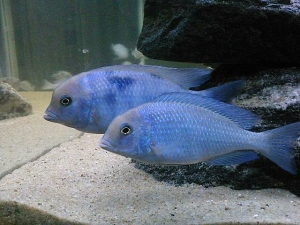
Difficulty: 2/5
Tank minimum: 75 gallon
Water parameters: 73F-82F, PH 7.3-8.8m GH Hard
Maximum size: 10″
Tank region: All over
Behavior: Aggressive, especially conspecific aggressive among males
Diet: Carnivore based. High quality pellet or flake, frozen or live meaty foods such as bloodworms, daphnia, brine, chopped earthworms and other invertebrates. Avoid tubifex and beef heart.
Compatibility: Other similar sized rift cichlid with similar requirements. Use caution when housing more than one male.
Extra: The Blue Dolphin is a wonderful option for beginners as it is readily available, hardy, and fairly adaptable to conditions. While they are a slow grower, they can grow fairly large so 75 gallons is a minimum with ideally 125 or more. They can be housed with more mild mannered species of African cichlid, but it is not recommended to house more than one male unless you have a large tank as they can become quite aggressive.
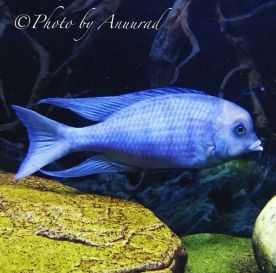
Some hobbyists use the ratio 3:1 with 3 females to 1 male, some choose 2:1, while others will simply house all males. In my opinion, there is no exact science to finding the right blend. I prefer the slightly overstocked method with lots of rock, hiding, and decorations to break line of sight. By slightly overstocking your tank it will help reduce aggression. It is extremely important to over filtrate and do regular weekly water changes on your African tanks as higher PH can make ammonia more toxic. Overstocking makes it even more imperative to have extra filtration as well. Stay tuned for an article on the art of overstocking.
Dimidiochromis Compressiceps
“Malawi Eye Biter”

Difficulty: 3/5
Tank minimum: 100 gallons
Water parameters: 73F-82F, PH 7.7-8.8, GH 6-10
Maximum size: 12″
Tank region: All over
Behavior: Aggressive, Males highly conspecific aggressive with other males
Diet: Omnivore/Piscivore based. High quality pellet or flake, frozen or live foods such as spirulina, bloodworms, daphnia, brine,silversides, mussel, prawns, and other invertebrates, as well as some veggies. Avoid tubifex and beef heart.
Compatibility: Other similar size or larger species of cichlid. Avoid smaller species that can be eaten or Mbuna.
Extra: Nicknamed the “Malawi Eye Biter” they are actually no more likely to bite at the eyes of other fish than other cichlid. Males can get highly aggressive amongst themselves, and they can be predatory to smaller fish; they are otherwise fairly mild mannered. They can reach up to 12″, though they are usually closer to 10″. Adults should be kept in a 100 gallon as an absolute minimum and a few hundred gallons is recommended when keeping more than one male.
There is no exact science when stocking your African Cichlid tanks. I prefer the slightly overstocked method with lots of rock, hiding, and decorations to break line of sight. By slightly overstocking your tank it will help reduce aggression. It is extremely important to over filtrate and do regular weekly water changes on your African tanks as higher PH can make ammonia more toxic. Overstocking makes it even more imperative to have extra filtration as well. Stay tuned for an article on the art of overstocking.
Labidochromis Caeruleus
“Electric Yellow Lab”
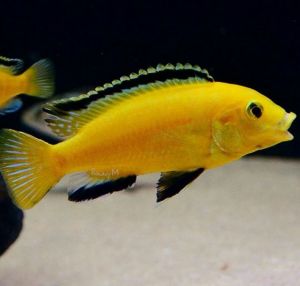
Difficulty: 2/5
Tank minimum: 50 gallon
Water parameters: 75F-82F, PH 7.5-8.8, GH Hard 10-20
Maximum size: 5″
Tank region: All over
Behavior: Mildly Aggressive
Diet: Omnivore based. High quality pellet or flake, frozen or live foods such as spirulina, bloodworms, daphnia, brine, and other invertebrates, as well as some veggies. Avoid tubifex and beef heart.
Compatibility: Adaptable for most rift communities. Does best with other peaceful Malawi species.
Extra: One of the most readily available African cichlids in the hobby, the Yellow Lab is a popular choice for beginners. It is extremely hardy, very adaptable, and a forgiving species. It is also one of the most peaceful Malawi species. They can get up to 5″ but are usually found closer to 3″-4″. They will accept most foods, but make sure to include veggies into their diet to avoid Malawi Bloat.

There is no exact science when stocking your African Cichlid tanks. I prefer the slightly overstocked method with lots of rock, hiding, and decorations to break line of sight. By slightly overstocking your tank it will help reduce aggression. It is extremely important to over filtrate and do regular weekly water changes on your African tanks as higher PH can make ammonia more toxic. Overstocking makes it even more imperative to have extra filtration as well. Stay tuned for an article on the art of overstocking.
Maylandia Lombardoi
“Kenyi”
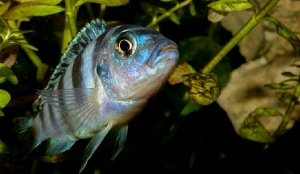
Difficulty: 3/5
Tank minimum: 75 gallon
Water parameters: 73F-82F, PH 7.8-8.8, GH Hard
Maximum size: 6″
Tank region: All over
Behavior: Aggressive
Diet: Omnivore/Herbivore based. High quality pellet or flake rich with vegetable matter such as zucchini, spinach, and peas. Can include plankton, crustaceans, zooplankton. Brine, mysis, daphnia, and bloodworms can be fed on occasion. Spirulina should be included to keep their colors vibrant. Avoid too much protein, tubifex, and beef heart.
Compatibility: Other aggressive Mbuna.
Extra: The Kenyi a popular choice for hobbyists keeping Mbuna tanks. Like other Mbuna, the Kenyi can be quite aggressive, particularly among males. For this reason it is recommended to have a 100 gallon or more when keeping two males of the same species. The Kenyi starts off as a blue fish with blue barring, but the males will slowly turn yellow as it matures, which throws off unexpected fish keepers. It is also extremely important to avoid too much protein in their diet, as well as not overfeeding because they risk getting “Malawi Bloat” which is usually always fatal.
There is no exact science when stocking your African Cichlid tanks. I prefer the slightly overstocked method with lots of rock, hiding, and decorations to break line of sight. This is almost an absolute necessity to do when keeping Mbuna. By slightly overstocking your tank it will help reduce aggression. It is extremely important to over filtrate and do regular weekly water changes on your African tanks as higher PH can make ammonia more toxic. Overstocking makes it even more imperative to have extra filtration as well. Stay tuned for an article on the art of overstocking.
Melanochromis Auratus
“Auratus”

Difficulty: 4/5
Tank minimum: 75 gallon
Water parameters: 73F-82F, PH 7.7-8.8, GH Hard 6-10
Maximum size: 5″
Tank region: All over
Behavior: Extremely Aggressive
Diet: Omnivore/Herbivore based. High quality pellet or flake rich with vegetable matter, frozen foods can be fed as a treat sparingly. Spirulina should be included to keep their colors vibrant. Avoid too much protein, tubifex, and beef heart.
Compatibility: Other aggressive Mbuna. Avoid species that look similar in appearance. Males should not be housed together.
Extra: The Auratus is a highly aggressive Mbuna species that isn’t suitable for beginners due to it’s aggressive nature. Males are not only aggressive to other males, but have been known to kill females as well. Dominant females have also been known to kill subordinate males. 75 gallons is the absolute minimum when keeping this fish, though it is highly recommended they are kept in 125 gallons or larger. It is also extremely important to avoid too much protein in their diet, as well as not overfeeding because they risk getting “Malawi Bloat” which is usually always fatal.

There is no exact science when stocking your African Cichlid tanks. I prefer the slightly overstocked method with lots of rock, hiding, and decorations to break line of sight. This is almost an absolute necessity to do when keeping Mbuna. By slightly overstocking your tank it will help reduce aggression. It is extremely important to over filtrate and do regular weekly water changes on your African tanks as higher PH can make ammonia more toxic. Overstocking makes it even more imperative to have extra filtration as well. Stay tuned for an article on the art of overstocking.
Metriaclima Callainos
“Cobalt Blue Zebra”

Difficulty: 3/5
Tank minimum: 55 gallon
Water parameters: 73F-82F, PH 7.8-8.8, GH Hard
Maximum size: 6″
Tank region: All over
Behavior: Aggressive
Diet: Omnivore/Herbivore based. High quality pellet or flake rich with vegetable matter, frozen foods can be fed as a treat sparingly. Spirulina should be included to keep their colors vibrant. Avoid too much protein, tubifex, and beef heart.
Compatibility: Other aggressive Mbuna.
Extra: The Cobalt Blue Zebra is a popular choice for hobbyists keeping Mbuna tanks. Like other Mbuna, the Cobalt can be quite aggressive, particularly among males. For this reason it is recommended to have a 100 gallon or more when keeping two males of the same species. It is also extremely important to avoid too much protein in their diet, as well as not overfeeding because they risk getting “Malawi Bloat” which is usually always fatal.
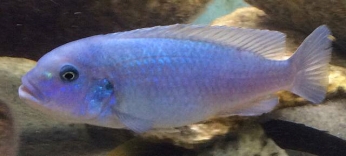
There is no exact science when stocking your African Cichlid tanks. I prefer the slightly overstocked method with lots of rock, hiding, and decorations to break line of sight. This is almost an absolute necessity to do when keeping Mbuna. By slightly overstocking your tank it will help reduce aggression. It is extremely important to over filtrate and do regular weekly water changes on your African tanks as higher PH can make ammonia more toxic. Overstocking makes it even more imperative to have extra filtration as well. Stay tuned for an article on the art of overstocking.
Metriaclima Estherae
“Red Zebra”
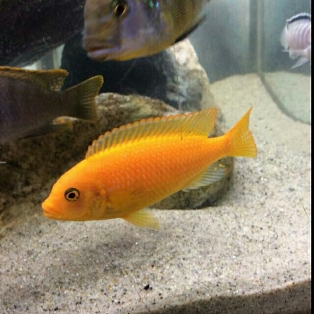
Difficulty: 3/5
Tank minimum: 55 gallon
Water parameters: 73F-82F, PH 7.8-8.8, GH Hard
Maximum size: 5″
Tank region: All over
Behavior: Aggressive
Diet: Omnivore/Herbivore based. High quality pellet or flake rich with vegetable matter, frozen foods can be fed as a treat sparingly. Spirulina should be included to keep their colors vibrant. Avoid too much protein, tubifex, and beef heart.
Compatibility: Other aggressive Mbuna.
Extra: The Red Zebra is a popular choice for hobbyists keeping Mbuna tanks. Like other Mbuna, the Ice Blue can be quite aggressive, particularly among males. For this reason it is recommended to have a 100 gallon or more when keeping two males of the same species. It is also extremely important to avoid too much protein in their diet, as well as not overfeeding because they risk getting “Malawi Bloat” which is usually always fatal.
There is no exact science when stocking your African Cichlid tanks. I prefer the slightly overstocked method with lots of rock, hiding, and decorations to break line of sight. This is almost an absolute necessity to do when keeping Mbuna. By slightly overstocking your tank it will help reduce aggression. It is extremely important to over filtrate and do regular weekly water changes on your African tanks as higher PH can make ammonia more toxic. Overstocking makes it even more imperative to have extra filtration as well. Stay tuned for an article on the art of overstocking.
Metriaclima Greshakei
“Ice Blue Zebra”
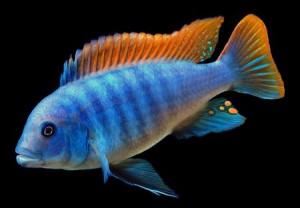
Difficulty: 3/5
Tank minimum: 55 gallon
Water parameters: 73F-82F, PH 7.8-8.8, GH Hard
Maximum size: 6″
Tank region: All over
Behavior: Aggressive
Diet: Omnivore/Herbivore based. High quality pellet or flake rich with vegetable matter, frozen foods can be fed as a treat sparingly. Spirulina should be included to keep their colors vibrant. Avoid too much protein, tubifex, and beef heart.
Compatibility: Other aggressive Mbuna.
Extra: The Ice Blue, also known as the Red Top or William’s Mbuna, is a popular choice for hobbyists keeping Mbuna tanks. Like other Mbuna, the Ice Blue can be quite aggressive, particularly among males. For this reason it is recommended to have a 100 gallon or more when keeping two males of the same species. It is also extremely important to avoid too much protein in their diet, as well as not overfeeding because they risk getting “Malawi Bloat” which is usually always fatal.
There is no exact science when stocking your African Cichlid tanks. I prefer the slightly overstocked method with lots of rock, hiding, and decorations to break line of sight. This is almost an absolute necessity to do when keeping Mbuna. By slightly overstocking your tank it will help reduce aggression. It is extremely important to over filtrate and do regular weekly water changes on your African tanks as higher PH can make ammonia more toxic. Overstocking makes it even more imperative to have extra filtration as well. Stay tuned for an article on the art of overstocking.
Nimbochromis Livingstonii
“Livingstoni”

Difficulty: 3/5
Tank minimum: 125 gallon
Water parameters: 73F-82F, PH 7.7-8.8, GH Hard 6-10
Maximum size: 12″
Tank region: All over
Behavior: Mildly Aggressive, Predatory
Diet: Omnivore/Piscivore based. High quality pellet or flake, frozen or live foods such as spirulina, bloodworms, daphnia, brine,silversides, mussel, prawns, and other invertebrates, as well as some veggies. Avoid tubifex and beef heart.
Compatibility: Other large rift cichlids. Does well with other haplochgromis. Can be housed with large lake cichlids like Frontosa, though they are from a different lake. Avoid small species that can be eaten.
Extra: The Livingstonii has been nicknamed Kaligono, or “sleeper”, by the locals due to it’s unique style of hunting. The Livingstonii will feign death and lay on it’s side waiting for unsuspecting fish to swim by and allow it to ambush. While the Livingstonii can get up to 12″ it usually stays closer to 10″. Due to this large size, it is recommended to keep this fish in a 125 gallon minimum.

There is no exact science when stocking your African Cichlid tanks. I prefer the slightly overstocked method with lots of rock, hiding, and decorations to break line of sight. By slightly overstocking your tank it will help reduce aggression. It is extremely important to over filtrate and do regular weekly water changes on your African tanks as higher PH can make ammonia more toxic. Overstocking makes it even more imperative to have extra filtration as well. Stay tuned for an article on the art of overstocking.
Nimbochromis Venustus
“Venustus”
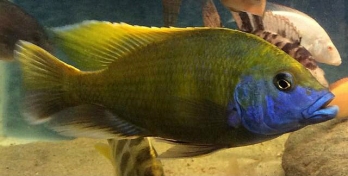
Difficulty: 3/5
Tank minimum: 70 gallon for juveniles, 125 gallon
Water parameters: 73F-82F, PH 7.7-8.8, GH Hard 6-10
Maximum size: 10″
Tank region: All over
Behavior: Aggressive, Predatory
Diet: Omnivore/Piscivore based. High quality pellet or flake, frozen or live foods such as spirulina, bloodworms, daphnia, brine,silversides, mussel, prawns, and other invertebrates, as well as some veggies. Avoid tubifex and beef heart.
Compatibility: Other large rift cichlids. Does well with other haplochgromis. Can be housed with large lake cichlids like Frontosa, though they are from a different lake. Avoid small species that can be eaten.
Extra: The Venustus, like the Livingstonii also feigns death as a hunting tactic. They will feign death and lay on it’s side waiting for unsuspecting fish to swim by and allow it to ambush. There is no exact science when stocking your African Cichlid tanks. I prefer the slightly overstocked method with lots of rock, hiding, and decorations to break line of sight. By slightly overstocking your tank it will help reduce aggression. It is extremely important to overfiltrate and do regular weekly water changes on your African tanks as higher PH can make ammonia more toxic. Overstocking makes it even more imperative to have extra filtration as well. Stay tuned for an article on the art of overstocking.
Protomelas sp.
“Steveni Taiwan” (Taiwan Reef)

Difficulty: 2/5
Tank minimum: 55 gallon
Water parameters: 78F-82F, PH 7.8-8.8, GH Hard
Maximum size: 7″
Tank region: All over
Behavior: Mildly aggressive
Diet: Omnivore/Herbivore based. High quality pellet or flake rich with vegetable matter with spirulina. Can include plankton, crustaceans, zooplankton. Brine, mysis, daphnia, and bloodworms can be fed on occasion. Spirulina should be included to keep their colors vibrant. Avoid too much protein, tubifex, and beef heart.
Compatibility: Other Malawi species of similar size and temperament. The overly aggressive Mbuna may not be suitable tankmates.
Extra: The Taiwan Reef is a stunning fish that would make a great addition to any mildly aggressive Malawi tank. They can reach 7″ in size, but are usually found closer to 5″-6″.
There is no exact science when stocking your African Cichlid tanks. I prefer the slightly overstocked method with lots of rock, hiding, and decorations to break line of sight. By slightly overstocking your tank it will help reduce aggression. It is extremely important to overfiltrate and do regular weekly water changes on your African tanks as higher PH can make ammonia more toxic. Overstocking makes it even more imperative to have extra filtration as well. Stay tuned for an article on the art of overstocking.
Pseudotropheus Crabro
“Bumblebee”

Difficulty: 3/5
Tank minimum: 75 gallon
Water parameters: 78F-82F, PH 7.8-8.8, GH Hard
Maximum size: 8″
Tank region: All over
Behavior: Aggressive, especially aggressive with males
Diet: Omnivore based. High quality pellet or flake, frozen or live foods such as bloodworms, daphnia, brine, and other invertebrates. Avoid tubifex and beef heart. Vegetable matter should still be included.
Compatibility: Similar size and temperament Mbuna.
Extra: The Bumblebee is a large Mbuna cichlid that eats parasites off of catfish in the wild. It can be quite aggressive and is recommended to be housed with other more aggressive species of fish. Avoid keeping two males together unless your aquarium is much larger. They do require more protein in their diet than some Mbuna, but some sort of vegetable matter should still be included.

Some hobbyists use the ratio 6:1 with 6 females to 1 male, some choose 2:1, while others will simply house all males. In my opinion, there is no exact science to finding the right blend. I prefer the slightly overstocked method with lots of rock, hiding, and decorations to break line of sight. By slightly overstocking your tank it will help reduce aggression. It is extremely important to over filtrate and do regular weekly water changes on your African tanks as higher PH can make ammonia more toxic. Overstocking makes it even more imperative to have extra filtration as well. Stay tuned for an article on the art of overstocking.
Pseudotropheus Demasoni
“Demasoni”
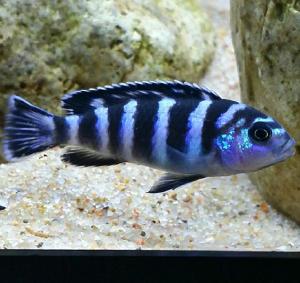
Difficulty: 3/5
Tank minimum: 55 gallon
Water parameters: 78F-82F, PH 7.8-8.8, GH Hard 10-18
Maximum size: 4″
Tank region: All over
Behavior: Aggressive
Diet: Omnivore/Herbivore based. High quality pellet or flake rich with vegetable matter, frozen foods can be fed as a treat sparingly. Spirulina should be included to keep their colors vibrant. Avoid too much protein, tubifex, and beef heart.
Compatibility: Other aggressive Mbuna. Avoid species similar in appearance.
Extra: What the Demasoni lacks in size, it makes up for in attitude. This little fish can be quite aggressive and should only be housed with other aggressive species. It is also extremely important to avoid too much protein in their diet, as well as not overfeeding because they risk getting “Malawi Bloat” which is usually always fatal.
There is no exact science when stocking your African Cichlid tanks. I prefer the slightly overstocked method with lots of rock, hiding, and decorations to break line of sight. This is almost an absolute necessity to do when keeping Mbuna. By slightly overstocking your tank it will help reduce aggression. It is extremely important to overfiltrate and do regular weekly water changes on your African tanks as higher PH can make ammonia more toxic. Overstocking makes it even more imperative to have extra filtration as well. Stay tuned for an article on the art of overstocking.
Cichlid, Lake Victorian
Astatotilapia Latifasciata “Zebra Obliquiden”
Astatotilapia Nubila “Blue Victorian”
Haplochromis sp. “#44 thickskin”
Pundamilia Nyererei “Ruti Island”
Xystichromis sp. “Kyoga Flameback”
Astatotilapia Latifasciata
“Zebra Obliquiden”
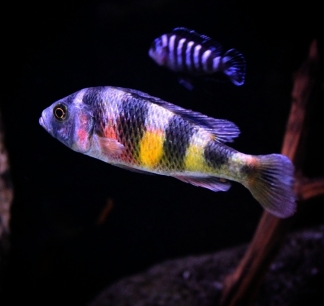
Difficulty: 2/5
Tank minimum: 55 gallons
Water parameters: 74F-81F, PH 7.2-8.6, GH moderately hard
Maximum size: 5″
Tank region: All over
Behavior: Mildly Aggressive
Diet: Omnivore/Insectivore based. High quality pellet or flake, as well live or frozen foods such as brine, mosquito larva, cyclops, and daphnia.
Compatibility: Suitable in an African community, avoid overly aggressive species.
Extra: The Zebra Obliquiden, part of a subspecies of haps, is a wonderful choice for beginners looking to start an african cichlid tank. They are fairly hardy, aren’t too fussy with water parameters and on the more peaceful side as far as african cichlids go. There should be plenty of hiding places with this species or they tend to feel insecure and hide more.
There is no exact science when stocking your African Cichlid tanks. I prefer the slightly overstocked method with lots of rock, hiding, and decorations to break line of sight. By slightly overstocking your tank it will help reduce aggression. It is extremely important to over-filtrate and do regular weekly water changes on your African tanks as higher PH can make ammonia more toxic. Overstocking makes it even more imperative to have extra filtration as well. Stay tuned for an article on the art of overstocking.
Astatotilapia Nubila
“Blue Victorian”

Difficulty: 3/5
Tank minimum: 55 gallons
Water parameters: 74F-81F, PH 7.5-8.6, GH moderately hard
Maximum size: 4″
Tank region: All over
Behavior: Aggressive, especially conspecific
Diet: Omnivore/Insectivore based. High quality pellet or flake, as well live or frozen foods such as brine, mosquito larva, cyclops, worms, shrimp, and daphnia.
Compatibility: African community. Males can be highly aggressive conspecific and other haps
Extra: The Blue Victorian is one of the first Lake Victorian cichlids to be discovered and classified. While this species may be small, it makes up for it in attitude. It has been known to be fairly aggressive, particularly males with other males. As long as their water is kept in good condition, they are fairly hardy and are not fussy about food.
There is no exact science when stocking your African Cichlid tanks. I prefer the slightly overstocked method with lots of rock, hiding, and decorations to break line of sight. By slightly overstocking your tank it will help reduce aggression. It is extremely important to over-filtrate and do regular weekly water changes on your African tanks as higher PH can make ammonia more toxic. Overstocking makes it even more imperative to have extra filtration as well. Stay tuned for an article on the art of overstocking.
Haplochromis sp.
“#44 thickskin”

Difficulty: 3/5
Tank minimum: 55 gallons
Water parameters: 74F-81F, PH 7.5-8.6, GH moderately hard
Maximum size: 5″
Tank region: All over
Behavior: Aggressive, especially conspecific
Diet: Omnivore/Insectivore based. High quality pellet or flake, as well live or frozen foods such as brine, mosquito larva, cyclops, worms, shrimp, and daphnia.
Compatibility: Best with more aggressive African community. Males can be highly aggressive conspecific and other haps
Extra: The Thickskin variety is one of the more aggressive species of haps and is not as suitable with peaceful peacocks and haps. It would do best with more aggressive fish with a similar temperament, but use caution when housing with species that look similar.
There is no exact science when stocking your African Cichlid tanks. I prefer the slightly overstocked method with lots of rock, hiding, and decorations to break line of sight. By slightly overstocking your tank it will help reduce aggression. It is extremely important to over-filtrate and do regular weekly water changes on your African tanks as higher PH can make ammonia more toxic. Overstocking makes it even more imperative to have extra filtration as well. Stay tuned for an article on the art of overstocking.
Pundamilia Nyererei
“Ruti Island”
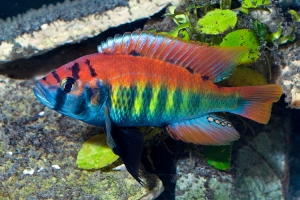
Difficulty: 2/5
Tank minimum: 55 gallons
Water parameters: 74F-81F, PH 7.5-8.6, GH hard
Maximum size: 4″
Tank region: All over
Behavior: Aggressive
Diet: Omnivore based. High quality pellet or flake and should include vegetable matter, as well live or frozen foods such as brine, mosquito larva, cyclops, worms, shrimp, and daphnia. . Spirulina should be included to keep their colors vibrant. Avoid too much protein, tubifex, and beef heart.
Compatibility: In most african lake communities.
Extra: One of the most colorful of haps and other Lake Victorian cichlids, the P. Nyererei is a great choice for those looking to add some color to their tank. They aren’t overly aggressive and can work in a Victorian, Mbuna, or mixed community fairly well. Males can be aggressive towards one another so it is important to have lots of hiding and preferably larger aquarium.
There is no exact science when stocking your African Cichlid tanks. I prefer the slightly overstocked method with lots of rock, hiding, and decorations to break line of sight. By slightly overstocking your tank it will help reduce aggression. It is extremely important to over-filtrate and do regular weekly water changes on your African tanks as higher PH can make ammonia more toxic. Overstocking makes it even more imperative to have extra filtration as well. Stay tuned for an article on the art of overstocking.
Xystichromis sp.
“Kyoga Flameback”
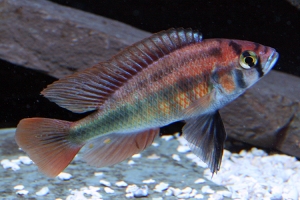
Difficulty: 3/5
Tank minimum: 55 gallon
Water parameters: 74F-81F, PH 7.5-8.6, GH hard
Maximum size: 6″
Tank region: All over
Behavior: Mildly aggressive
Diet: Omnivore/Herbivore based. High quality pellet or flake rich with vegetable matter, frozen foods can be fed as a treat sparingly. Spirulina should be included to keep their colors vibrant. Avoid too much protein, tubifex, and beef heart.
Compatibility: Suitable for a peaceful/mildly aggressive African community.
Extra: The Kyoga Flameback, or Kyoga Allred, is often confused with the Xystichromis “flameback” due to their similar names, however, the Kyoga Flameback looks much different. The Kyoga Flameback is one of the more common known species of Victorian and is known for being quite colorful. While they can get up to 6″, the males are usually closer to 5″ and the females 3.5″. They are not known for being overly aggressive, but are best in a larger tank as their aggression increases in smaller aquariums.
There is no exact science when stocking your African Cichlid tanks. I prefer the slightly overstocked method with lots of rock, hiding, and decorations to break line of sight. By slightly overstocking your tank it will help reduce aggression. It is extremely important to over-filtrate and do regular weekly water changes on your African tanks as higher PH can make ammonia more toxic. Overstocking makes it even more imperative to have extra filtration as well. Stay tuned for an article on the art of overstocking.
Cichlid, Lake Tanganyikan
Altolamprologus Calvus “Calvus”
Cyphotilapia Frontosa “Frontosa”
Julidochromis Dickfeldi “Brown Julie”
Julidochromis Marlieri “Spotted Julie”
Julidochromis Ornatus “Golden Julie”
Julidochromis Regani “Convict Julie”
Julidochromis Transcriptus “Masked Julie”
Tropheus Brichardi “Blue Eyed Tropheus”
Tropheus Duboisi “White Spotted Tropheus”
Tropheus Moorii “Blunt Head Tropheus”
←Back
Altolamprologus calvus
“Calvus”
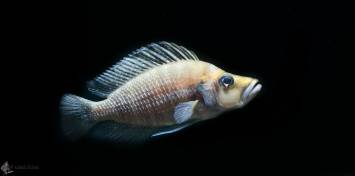
Difficulty: 2/5
Tank minimum: 50 gallon
Water parameters: 74F-79F, PH 8.6-9.1, GH very hard
Maximum size: 6″
Tank region: All over, mostly mid-bottom dwelling
Behavior: Mildly aggressive
Diet: Carnivore based. High quality pellet as well as live or frozen foods such as mysis, krill, brine, earthworms, bloodworms, etc. Avoid tubifex and beefheart.
Compatibility: Other peaceful tanganyikan cichlids. Avoid aggressive species such mbuna.
Extra: The Calvus can range in color from a pearly white to black. It is fairly hardy as long as it’s needs are met. While this fish will need a 50 gallon minimum as an adult, they are incredibly slow growers and can easily live in a 30-40 gallon aquarium for some time. They do best with other peaceful tanganyikan and can usually live with adult shelldwellers without issues or risk of eating them. Unlike a lot of African cichlid, they require more protein in their diet and they don’t do well with overstocked tanks either. Regular weekly water changes are a must and like most Tanganyikan cichlids they require a heavily oxygenated aquarium which can be done with an airstone. Stay tuned on my article on keeping ideal rift environments.
Cyphotilapia Frontosa
“Frontosa”
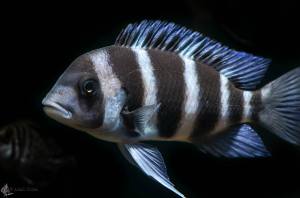

Difficulty: 2/5
Tank minimum: 75 gallons for solo adult or juvenile group
Water parameters: 75F-79F, PH 8.0-9.5, GH very hard
Maximum size: 16″
Tank region: All over
Behavior: Mildly aggressive
Diet: Carnivore based diet. Should include high quality pellet. Can include a variety of live or frozen meaty foods such as snails, shellfish, krill, mysis, brine, worms, worms, crustaceans, etc.
Compatibility: Gregarious, prefer to be in groups. Does best with other larger, mild mannered Tanganyika cichlid.
Extra: The Frontosa is a large cichlid that is fairly easy as long as it’s needs are properly met. Unlike a lot of African cichlid, the Frontosa is requires more protein in it’s diet. With striking dark bars and bright blue fins, this fish is a spectacular fish to keep. Although a 75 gallon is a minimum for juvenile, a 125 gallon should be the minimum for an older group and a 200 gallon is ideal. They do like the company of their own kind and do best in either a group of one male and 3 females or a mixed group of 8-12. It is quite common for people to keep species only tanks with Frontosa to accommodate their needs. Unlike other African cichlids, they don’t necessarily do well in overstocked tanks either. Regular weekly water changes are a must and like most Tanganyikan cichlids they require a heavily oxygenated aquarium which can be done with an airstone. Stay tuned on my article on keeping ideal rift environments.
Julidochromis Dickfeldi
“Brown Julie”

Difficulty: 2/5
Tank minimum: 20 gallon for a pair, 55 gallon for community
Water parameters: 74F-79F, PH 8.6-9.2 GH very hard
Maximum size: 4″
Tank region: All over, mostly bottom
Behavior: Aggressive
Diet: Omnivore based. High quality pellet or flake and should include vegetable matter, as well live or frozen foods such as brine, mosquito larva, cyclops, worms, shrimp, and daphnia. Spirulina should be included to keep their colors vibrant. Avoid tubifex, and beef heart.
Compatibility: Does well in african community tanks. Can be kept alone or in pairs. Avoid other housing other julie species.
Extra: This mid-sized Julie species is fairly hardy and makes a great choice for beginner fish keepers. Though fairly shy, it can work in an African community tank as long as there aren’t other Julie present. Regular weekly water changes are a must and like most Tanganyikan cichlids they require a heavily oxygenated aquarium which can be done with an airstone. Stay tuned on my article on keeping ideal rift environments.
Julidochromis Marlieri
“Spotted Julie”
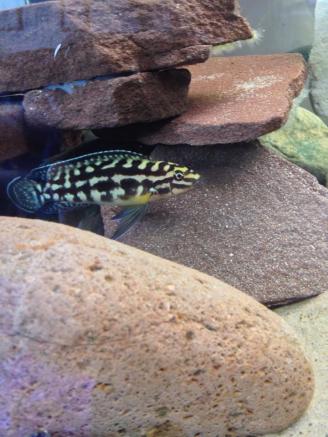
Difficulty: 2/5
Tank minimum: 20 gallon for a pair, 55 gallon for community
Water parameters: 75F-79F, PH 8.0-9.0, GH very hard
Maximum size: 5″
Tank region: All over, mostly bottom
Behavior: Aggressive
Diet: Omnivore based. High quality pellet or flake and should include vegetable matter, as well live or frozen foods such as brine, mosquito larva, cyclops, worms, shrimp, and daphnia. Spirulina should be included to keep their colors vibrant. Avoid tubifex, and beef heart.
Compatibility: Does well in african community tanks. Can be kept alone or in pairs. Avoid other housing other julie species.
Extra: This mid-sized Julie species is fairly hardy and makes a great choice for beginner fish keepers. Though fairly shy, it can work in an African community tank as long as there aren’t other Julie present. Regular weekly water changes are a must and like most Tanganyikan cichlids they require a heavily oxygenated aquarium which can be done with an airstone. Stay tuned on my article on keeping ideal rift environments.
Julidochromis Ornatus
“Golden Julie”

Difficulty: 2/5
Tank minimum: 20 gallon for a pair, 55 gallon for community
Water parameters: 75F-79F, PH 8.0-9.0, GH very hard
Maximum size: 3″
Tank region: Mostly bottom dwelling
Behavior: Aggressive
Diet: Omnivore based. High quality pellet or flake and should include vegetable matter, as well live or frozen foods such as brine, mosquito larva, cyclops, worms, shrimp, and daphnia. Spirulina should be included to keep their colors vibrant. Avoid tubifex, and beef heart.
Compatibility: Does well in african community tanks. Can be kept alone or in pairs. Avoid other housing other julie species.
Extra: This smaller Julie species is fairly hardy and makes a great choice for beginner fish keepers. Though fairly shy, it can work in an African community tank as long as there aren’t other Julie present. Regular weekly water changes are a must and like most Tanganyikan cichlids they require a heavily oxygenated aquarium which can be done with an airstone. Stay tuned on my article on keeping ideal rift environments.
Julidochromis Regani
“Convict Julie”
Difficulty: 2/5
Tank minimum: 20 gallon for a pair, 55 gallon for community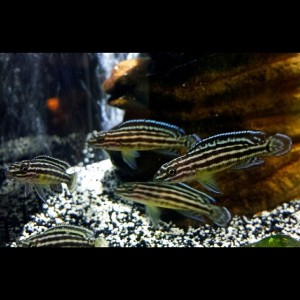
Water parameters: 75F-79F, PH 8.0-9.0, GH very hard
Maximum size: 6″
Tank region: All over, mostly bottom
Behavior: Mildly aggressive
Diet: Omnivore based. High quality pellet or flake and should include vegetable matter, as well live or frozen foods such as brine, mosquito larva, cyclops, worms, shrimp, and daphnia. Spirulina should be included to keep their colors vibrant. Avoid tubifex, and beef heart.
Compatibility: Work well in african cichlid tank with similar size and temperament. Generally tolerate others of the same species as long as they are raised together.
Extra: The J. Regani is one of the larger of the Julie species and can get up to 12″ in the wild. They rarely get that large in captivity and are usually found closer to 6″. They are also one of the more peaceful and tolerant species as well. The J. Regani is fairly hardy and makes a great choice for beginner fish keepers. Regular weekly water changes are a must and like most Tanganyikan cichlids they require a heavily oxygenated aquarium which can be done with an airstone. Stay tuned on my article on keeping ideal rift environments.
Julidochromis Transcriptus
“Masked Julie”
Difficulty: 2/5
Tank minimum: 20 gallon for a pair, 55 gallon for community
Water parameters: 75F-79F, PH 8.0-9.0, GH very hard
Maximum size: 3″
Tank region: All over, mostly bottom dwelling
Behavior: Aggressive
Diet: Omnivore based. High quality pellet or flake and should include vegetable matter, as well live or frozen foods such as brine, mosquito larva, cyclops, worms, shrimp, and daphnia. Spirulina should be included to keep their colors vibrant. Avoid tubifex, and beef heart.
Compatibility: Work well in african cichlid tank with similar size and temperament. Generally tolerate others of the same species, but will not tolerate their offspring once they hit 1″ in length.
Extra: One of the smaller species of Julie; the Transcriptus, or Masked Julie, is an excellent choice for beginners as it is fairly hardy. They are also fairly peaceful and tolerant of other species as well. Regular weekly water changes are a must and like most Tanganyikan cichlids they require a heavily oxygenated aquarium which can be done with an airstone. Stay tuned on my article on keeping ideal rift environments.
Tropheus Brichardi
“Blue Eyed Tropheus”

Difficulty: 4/5
Tank minimum: 75 gallon
Water parameters: 77F-79F, PH 8.0-9.0, GH very hard
Maximum size: 5″
Tank region: All over
Behavior: Aggressive
Diet: Herbivore based. High quality pellet or flake rich with vegetable matter and algae. Spirulina should be included to keep their colors vibrant. Avoid too much protein, tubifex, and beef heart.
Compatibility: Does best in a species specific tank and in a group of 10 or more
Extra: The T. Brichardi comes in a variety of different colors and is not a good choice for beginners. Tropheus are a fairly aggressive fish and while it is still up for debate on the best way to keep these fish, it is sometimes recommended to keep them as a species specific tank. They are also very prone to Malawi Bloat so it is extremely important to keep them strictly herbivore and their water conditions clean.
There is no exact science when stocking your African Cichlid tanks. I prefer the slightly overstocked method with lots of rock, hiding, and decorations to break line of sight. By slightly overstocking your tank it will help reduce aggression. It is extremely important to over-filtrate and do regular weekly water changes on your African tanks as higher PH can make ammonia more toxic. Overstocking makes it even more imperative to have extra filtration as well and like most Tanganyikan cichlids they require a heavily oxygenated aquarium which can be done with an airstone.. Stay tuned for an article on the art of overstocking.
Tropheus Duboisi
“White Spotted Tropheus”
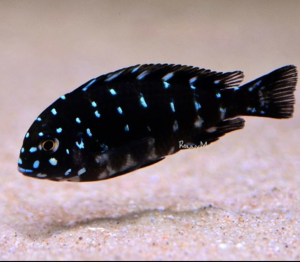
Difficulty: 4/5
Tank minimum: 75 gallon
Water parameters: 75F-79F, PH 8.0-9.0, GH very hard
Maximum size: 5″
Tank region: All over
Behavior: Aggressive
Diet: Herbivore based. High quality pellet or flake rich with vegetable matter and algae. Spirulina should be included to keep their colors vibrant. Avoid too much protein, tubifex, and beef heart.
Compatibility: Does best in a species specific tank and in a group of 10 or more
Extra: The T. Duboisi is one of those African species that changes look as they become adults. As juveniles they start as a little dark fish with white spots and as they get older, the spots disappeared and a yellow band starts to appear. This species is fairly aggressive and it’s recommended to keep in a species specific tank. They are also very prone to Malawi Bloat so it is extremely important to keep them strictly herbivore and their water conditions clean.

There is no exact science when stocking your African Cichlid tanks. I prefer the slightly overstocked method with lots of rock, hiding, and decorations to break line of sight. By slightly overstocking your tank it will help reduce aggression. It is extremely important to over-filtrate and do regular weekly water changes on your African tanks as higher PH can make ammonia more toxic. Overstocking makes it even more imperative to have extra filtration as well and like most Tanganyikan cichlids they require a heavily oxygenated aquarium which can be done with an airstone.. Stay tuned for an article on the art of overstocking.
Tropheus Moorii
“Blunt Head Tropheus”
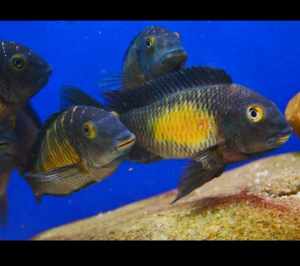
Difficulty: 4/5
Tank minimum: 75 gallon
Water parameters: 77F-79F, PH 8.0-9.0, GH very hard
Maximum size: 5 3/4″
Tank region: All over
Behavior: Aggressive
Diet: Herbivore based. High quality pellet or flake rich with vegetable matter and algae. Spirulina should be included to keep their colors vibrant. Avoid too much protein, tubifex, and beef heart.
Compatibility: Does best in a species specific tank and in a group of 10 or more
Extra: The T. Moorii, or Blunt Head, comes in a variety of different colors and is not a good choice for beginners. The T. Moorii is one of the most aggressive of Tropheus, and while it is still up for debate on the best way to keep these fish, it is sometimes recommended to keep them as a species specific tank. They are also very prone to Malawi Bloat so it is extremely important to keep them strictly herbivore and their water conditions clean.
There is no exact science when stocking your African Cichlid tanks. I prefer the slightly overstocked method with lots of rock, hiding, and decorations to break line of sight. By slightly overstocking your tank it will help reduce aggression. It is extremely important to over-filtrate and do regular weekly water changes on your African tanks as higher PH can make ammonia more toxic. Overstocking makes it even more imperative to have extra filtration as well and like most Tanganyikan cichlids they require a heavily oxygenated aquarium which can be done with an airstone.. Stay tuned for an article on the art of overstocking.
Cichlid, Americas/New World
Amatitlania Nigrofasciata “Convict”
Amphilophus Citrinellus “Midas”
Amphilophus Labiatus “Red Devil”
Andinoacara Rivulatus “False Green Terror”
Andinoacara Stalsbergi “Green Terror”
Astronotus Ocellatus”Oscar”
Caquetaia Umbrifera “Umbee”
Cichla sp. “Peacock bass”
Cichlasoma Beani
Cichlasoma Grammodes
Ex-Cichlasoma Festae Red Terror
Ex-Cichlasoma Salvini
Flowerhorn
Herichthys Carpintis “Pearlscale”
Herichthys Cyanoguttatus “Texas”
Nandopsis Haitiensis “Black Nasty”
Nandopsis Tetracanthus “Cuban Cichlid”
Parachromis Dovii “Wolf Cichlid”
Parachromis Friedrichsthalii “Freddy”
Parachromis Loisellei
Parachromis Manganese “Jaguar”
Parachromis Motaguense “Red Tiger”
Paratheraps bifasciatus”Bifa”
Paratheraps Hartwegi
Paratheraps Synspilus “Red Head”
Rocio Octofasciata “Jack Dempsey”
Vieja Argentea “Silver Cichlid”
Vieja Maculicauda “Black Belt”
←Back
Amatitlania Nigrofasciata
“Convict”
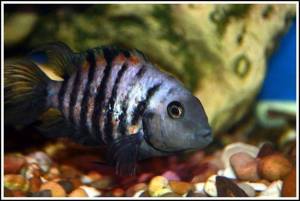
Difficulty: 1/5
Tank minimum: 30 gallon for a pair
Water parameters: 70F-83F, PH 6.5-8.0
Maximum size: 6″
Tank region: All over, mostly bottom dwelling
Behavior: Aggressive
Diet: Will except most foods. High quality pellet or flake, as well as live or frozen foods such as worm, shrimp, mussels, etc.
Compatibility: Cichlids with similar temperaments. Can hold its own with larger, more aggressive tankmates.
Extra: The convict cichlid is a great choice for beginners looking to start a cichlid tank. They are inexpensive, extremely hardy, and easy to care for. They can be kept with larger species since they can be quite tough. It’s said that the only thing it takes to get this fish to breed is to simply “add water.” As in, they will indefinitely start to breed if there is a male and female, and will start at a young age. While it’s wonderful to see cichlids do what they do best, “parent,” it can be undesirable as most cichlid can become hyper aggressive once they start to spawn. To avoid this only keep same gender convicts together which can be distinguished by the orange belly on the females. Be warned, they can still pair up with some other American species, but you will greatly reduce the risk of pairing separating convicts. This species is known to be quite destructive with live plants.
Amphilophus Citrinellus
“Midas”

Difficulty: 3/5
Tank minimum: 55 gallon for solo adult
Water parameters: 73F-81F, PH 6.8-7.5
Maximum size: 14″
Tank region: All over
Behavior: Aggressive
Diet: Omnivore based. Will except most foods. High quality pellet or flake, as well as live or frozen foods such as worm, shrimp, mussels, etc.
Compatibility: Other robust cichlids with similar size and temperament.
Extra: Often mistaken for the Red Devil, the Midas can be distinguished by their smaller lips, bulkier size, and larger nachual hump. From above, the Midas will have a “U” face vs. the Red Devil who has a “V” face. Like most cichlids, it is fairly hardy as long as it’s needs are met. They have a large bioload so it’s important to have heavy filtration and regular water changes. This species is known to be quite destructive with live plants.
Amphilophus Labiatus
“Red Devil”


Difficulty: 3/5
Tank minimum: 125 gallon, 55 gallon for smaller solo adult
Water parameters: 75F-80F, PH 6.5-7.5
Maximum size: 12″
Tank region: All over
Behavior: Aggressive, especially conspecific
Diet: Omnivore based. Will accept most foods and should include a high quality pellet, as well as a variety of live or frozen foods such as worms, bloodworms, brine, mysis, prawn, mussle.
Compatibility: Other robust cichlids with similar size and temperament.
Extra: Often mistaken for the Midas, the Red Devil can be distinguished by their larger lips and longer size. From above, the Midas will have a “U” face vs. the Red Devil who has a “V” face. Like most cichlids, it is fairly hardy as long as it’s needs are met. They have a large bioload so it’s important to have heavy filtration and regular water changes. This species is known to be quite destructive with live plants.
Andinoacara Rivulatus
“False Green Terror”
Difficulty: 3/5
Tank minimum: 75 gallon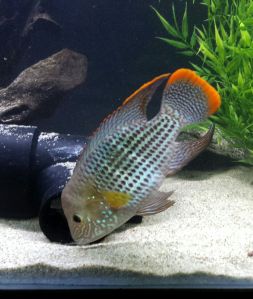
Water parameters: 72F-82F, PH 6.5-7.5
Maximum size: 10″
Tank region: All over
Behavior: Aggressive
Diet: Will except most foods. High quality pellet or flake, as well as live or frozen foods such as worm, shrimp, brine, etc.
Compatibility: Other robust cichlids with similar size and temperament.
Extra: Often labeled in fish stores as “Green Terror”, the Rivulatus is actually not the true green terror, though it is much more common. Compared to it’s relative, the Stalsbergi, it is much more evenly tempered and is not quite the “terror” it’s often confused for. While it isn’t nearly as aggressive, it still has been known to have an attitude so it’s important to have a large aquarium if you plan to keep this fish with tank mates. Like most cichlids, it is fairly hardy as long as it’s needs are met; though they have been known to be susceptible to internal parasites and can be difficult to treat. They have a large bioload so it’s important to have heavy filtration and regular water changes, especially since this species is known to get HITH in poor water conditions. This species is known to be quite destructive with live plants
Back to the top
Andinoacara Stalsbergi
“Green Terror”
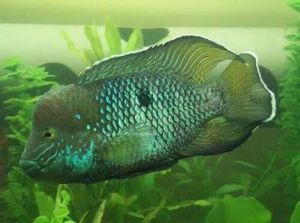
Difficulty: 3/5
Tank minimum: 90 gallons
Water parameters: 75F-80F, PH 6.0-7.8
Maximum size: 10″
Tank region: All over
Behavior: Aggressive, especially conspecific
Diet: Will except most foods. High quality pellet or flake, as well as live or frozen foods such as worm, shrimp, brine, etc.
Compatibility: Other robust cichlids with similar size and temperament.
Extra: The true Green Terror is the Stalsbergi, though this species is extremely uncommon in the trade. The Stalsbergi does live up to it’s name and can be quite aggressive compared to the Rivulatus. For this reason, care should be given when choosing tank mates. Like most cichlids, it is fairly hardy as long as it’s needs are met; though they have been known to be susceptible to internal parasites and can be difficult to treat. They have a large bioload so it’s important to have heavy filtration and regular water changes, especially since this species is known to get HITH in poor water conditions. This species is known to be quite destructive with live plants
Astronotus Ocellatus
“Oscar”
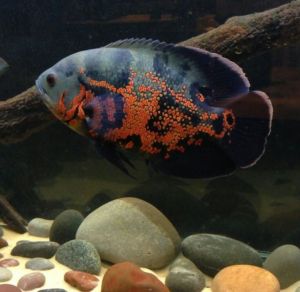
Difficulty: 2/5
Tank minimum: 75 gallon
Water parameters: 73F-82F, PH 6.0-8.0
Maximum size: 12″
Tank region: All over
Behavior: Mildly aggressive
Diet: Omnivore based. Will except most foods. High quality pellet or flake, as well as live or frozen foods such as worm, shrimp, mussels, etc.
Compatibility: Other robust cichlids with similar size and temperament.
Extra: The Oscar is another popular cichlid in the trade. They are extremely hardy and have a lovable personality making them a wonderful option for beginners. Though many are tempted to purchase cute little juveniles interacting with them, I don’t recommend taking an oscar home unless you plan to house this fish in an adequate size aquarium. Many stores will not take an oscar that has outgrown an aquarium, and the ones that do usually have a difficult time finding a new home. The Oscar has been dubbed a “Wet Pet” due to their personalities and love for their owners. They can be quite emotional fish that are known for sulking or even throwing a tantrum to show their dismay. They are very hardy, but do not take advantage of their tolerance for poor conditions as they can be prone to HITH (Hole in the Head Disease) which can be quite unattractive and difficult to heal. They have a large bioload so it’s important to have heavy filtration and regular water changes. This species is known to be quite destructive with live plants.
Caquetaia Umbrifera
“Umbee”
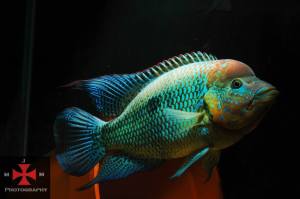
Difficulty: 4/5
Tank minimum: 100 gallon for seperated single pair+
Water parameters: 77F-82F, PH 7.0-7.9
Maximum size: 24″ male, 14″ female
Tank region: All over
Behavior: Extremely aggressive
Diet: Omnivore based. Will accept most foods and should include a high quality pellet, as well as a variety of live or frozen foods such as worms, bloodworms, spirulina, brine, mysis, prawn, mussle.
Compatibility: Other robust cichlids with similar size and temperament. Best kept solo.
Extra: The Umbie is a beautiful fish that is still relatively new to the hobby. There are a few varieties of this fish such as the Gorillus Black created by Umbee King. This fish is not for the timid as it fits in the category of “glass banger” and can be quite aggressive, even with it’s owner. If you have the pleasure of getting one with this type of aggression, it can make activities such as feeding, cleaning, and anything that may require you to open the lid of the tank fairly difficult. While some may attempt to keep this species with other fish, it’s not recommended since they can be ruthless and eventually take out other tank mates. If keeping a pair, it is highly recommended to have a divider for the female to escape through because the male may easily kill it’s mate if they have a lover’s quarrel. 100 gallon is the absolute mininum when keeping a full grown pair of these fish and it may be recommended to keep them in something closer to 300 gallons, especially if you opt to not get the divider. Lots of hiding places are recommended if keeping more than one fish in your aquarium, but avoid decorations that can be knocked over. Like most cichlids, it is fairly hardy as long as it’s needs are met. They have a large bioload so it’s important to have heavy filtration and regular water changes. This species is known to be quite destructive with live plants.
Cichla sp.
“Peacock bass”

Difficulty: 4/5
Tank minimum: 200 gallon+
Water parameters: 75F-82F, PH 6.5-7.5
Maximum size: 30″
Tank region: All over
Behavior: Aggressive/Predatory
Diet: Carnivore based. Will accept live foods such as worms, other insects, fish, and other meaty types. Can be trained onto frozen foods such as shrimp, mussels, worms, brine, bloodworms, etc. With patience, can be trained onto a carnivore based food such as Hikari Massivore.
Compatibility: Other large species such as arowana, stingrays, large catfish, and other large cichlids. Avoid any fish that can fit in this fish’s mouth (or even slightly larger) as this fish will consider it food.
Extra: The Peacock Bass is a popular choice among hobbyists when keeping a monster tank. Unfortunately, this fish is not suitable in MOST home aquariums since it gets quite large and is an extremely active fish. Decorations should be kept in moderation as this fish gets larger due to this activity level. There are many species of Peacock Bass such as the Ocellaris, Monoculus, Temensis, and the Orinocensis which are popular as a gaming fish among fishermen. This fish can be rewarding and interesting to keep, but is best kept for the advanced keepers.

Cichlasoma Beani
“Beani”

Difficulty: 5/5
Tank minimum: 75gallon
Water parameters: 74F-80F
Maximum size: 10″
Tank region: All over
Behavior: Extremely Aggressive, especially conspecific
Diet: Low protein extremely important, especially as juvenile.
Compatibility: Best in solo tank or as a pair, but can be housed with other cichlid of similar size and temperament.
Extra: This rare cichlid is a respectable addition to any serious fish keepers collection. It is also quite difficult to care for. The beani has a high mortality rate due to being extremely prone to bloat. They can get bloat fairly easily and can be caused by a number of things such as improper diet, overfeeding, and stress. For this reason, I would not recommend this species for anyone besides the advance keeper.
Cichasoma Grammodes
“Grammodes”
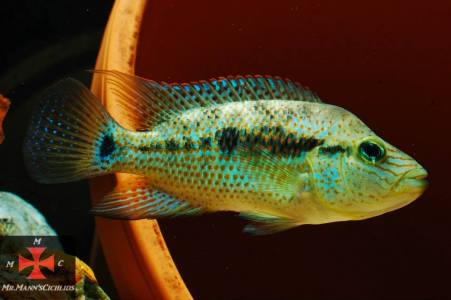

Difficulty: 4/5
Tank minimum: 75 gallon, 55 gallon for smaller individuals
Water parameters: 72F-81F, PH 7.0-8.0
Maximum size: 12″
Tank region: All over
Behavior: Extremely Aggressive
Diet: Carnivore based. Will except most foods. High quality pellet or flake, as well as live or frozen foods such as fish, worm, shrimp, mussels, etc.
Compatibility: Best kept solo. Can be kept with other robust cichlids with similar size and temperament but requires a large tank.
Extra: With it’s bad attitude, the grammodes has earned the name “Mini Dovii.” Though this fish is not mini as it can get up to 12″. However, while it can get almost a foot in length, it is a very slow grower and 9″-10″ is a more practical size. Can be kept with other cichilds, but avoid tankmates that are similar in appearance. It is speculated that this species is also prone to bloat, but others will argue that they are no more prone that other American cichlids. Regardless it is especially important for juveniles to avoid improper diet, overfeeding, and stress to reduce this chance.
Ex-Cichlasoma Festae
“Red Terror”

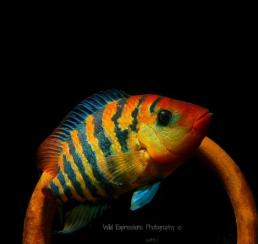
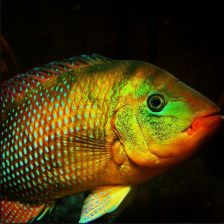
Difficulty: 4/5
Tank minimum: 75 gallon for solo fish, 125 for pair
Water parameters: 76F-82F, PH 7.0-7.8
Maximum size: 16″
Tank region: All over
Behavior: Extremely aggressive
Diet: Omnivore based. Will accept most foods and should include a high quality pellet, as well as a variety of live or frozen foods such as worms, bloodworms, spirulina, brine, mysis, prawn, mussle.
Compatibility: Other robust cichlids with similar size and temperament.
Extra: The Festae, also known as the Red Terror, is suitably named for it’s attitude; though it’s usually the females who live up to this name. Smaller in stature, the females are more brilliant marked with bold black baring and vibrant colors. Often confused with the Mayan, or False Red Terror; the “true” red terror can be distinguished by it’s caudal eye spot. The mayan will have a large eye spot that is large and placed in the middle. While the festae will have a smaller eye spot that takes up the upper 1/3 of the caudal area and the festae’s eye spot will usually also have a white edging around it. Like most cichlids, it is fairly hardy as long as it’s needs are met, though they do need extremely clean water in order to thrive. They have a large bioload so it’s important to have heavy filtration and regular weekly water changes. Use caution when keeping this species with live plants.
Ex-Cichlasoma Salvini
“Salvini”

Difficulty: 2/5
Tank minimum: 55 gallon
Water parameters: 72F-80F, PH 6.5-8.0
Maximum size: 8″
Tank region: All over
Behavior: Aggressive
Diet: Omnivore based. Will accept most foods and should include a high quality pellet, as well as a variety of live or frozen foods such as worms, bloodworms, spirulina, brine, mysis, prawn, mussle.
Compatibility: Larger, robust cichlid
Extra: This little spitfire of a cichlid packs a lot of punch for it’s size. It can hold it’s own fairly well against larger and more aggressive species. 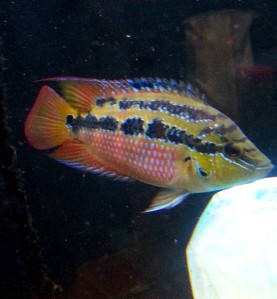 Female Salvini tend to be more vibrant and sometimes more aggressive. They can be distinguished by the blotch on the gill plate and dorsal fin, though this method isn’t always reliable and may still require venting for confirmation. Like most cichlids, it is fairly hardy as long as it’s needs are met, though they do need extremely clean water in order to thrive. They have a large bioload so it’s important to have heavy filtration and regular weekly water changes. Use caution when keeping live plants, though this species is known to leave them alone.
Female Salvini tend to be more vibrant and sometimes more aggressive. They can be distinguished by the blotch on the gill plate and dorsal fin, though this method isn’t always reliable and may still require venting for confirmation. Like most cichlids, it is fairly hardy as long as it’s needs are met, though they do need extremely clean water in order to thrive. They have a large bioload so it’s important to have heavy filtration and regular weekly water changes. Use caution when keeping live plants, though this species is known to leave them alone.
Flowerhorn
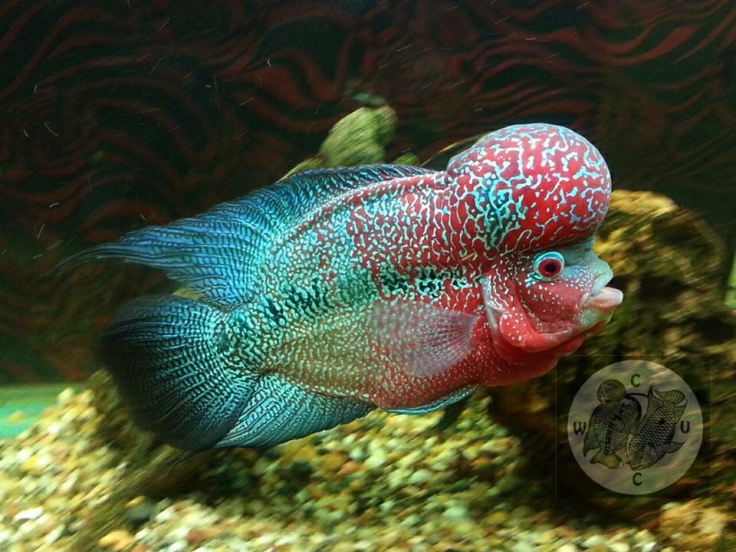

Difficulty: 3/5
Tank minimum: 50 gallon
Water parameters: 74F-82F, PH 6.8-7.8
Maximum size: 10″
Tank region: All over
Behavior: Aggressive
Diet: Pellet or Flake specifically designed for cichlids will suffice though it is recommended to have a diet high in protein for maximum growth. Foods high in krill or other natural color enhancements will bring out the best in your flowerhorn. There is pellets specifically for Flowerhorns, as well as for kok growth.
Compatibility: Best kept solo
Extra: As you may notice, the flowerhorn does not have a scientific name. That is due to the fact that this fish is actually a man-made hybrid originating from the Trimac. The flowerhorn has a following all on it’s own, however. The kok (or hump) on the head is the most desirable trait when keeping this fish and many strive to have the fish with the largest head. This fish is best kept solo as it can be quite aggressive. 50 gallons is a minimum when keeping a fish up to 8″ and many can live their entire lives in this aquarium. However, if your fish does end up larger they will need a 70 gallon minimum. Regular weekly water changes are a must in keeping your Flowerhorn is prime condition, as well as quality food.
Herichthys Carpintis
“Pearlscale”
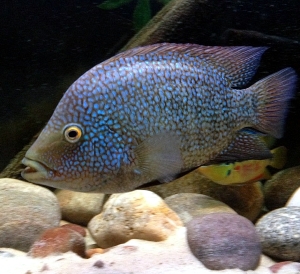
Difficulty: 2/5
Tank minimum: 55 gallon
Water parameters: 75F-80F, PH 7.0-8.0
Maximum size: 10″
Tank region: All over
Behavior: Aggressive, especially conspecific
Diet: Omnivore based. Will accept most foods and should include a high quality pellet, as well as a variety of live or frozen foods such as worms, bloodworms, spirulina, brine, mysis, prawn, mussle.
Compatibility: Other robust cichlids with similar size and temperament. Avoid conspecific
Extra: The Pearlscale, or Carpintis, is often mistaken for the Texas and are often mislabeled in fish stores. The Cyano is the “true” texas cichlid and is known as the blue texas. While the Carpintis is known as the green texas or pearlscale. The Carpintis can be distinguished by it’s larger pearls and is usually smaller in comparison to the Texas. Like most cichlids, it is fairly hardy as long as it’s needs are met, though they do need extremely clean water in order to thrive. They have a large bioload so it’s important to have heavy filtration and regular weekly water changes. Use caution when keeping this species with live plants.
Herichthys Cyanoguttatus
“Texas Cichlid”
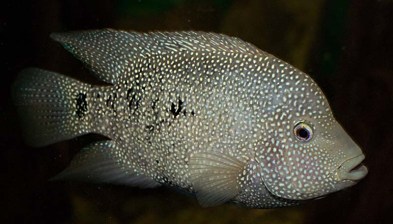
Difficulty: 3/5
Tank minimum: 60 gallon for solo adult
Water parameters: 70F-80F, PH 6.5-7.5
Maximum size: 12″
Tank region: All over
Behavior: Aggressive, especially conspecific
Diet: Omnivore based. Will accept most foods and should include a high quality pellet, as well as a variety of live or frozen foods such as worms, bloodworms, spirulina, brine, mysis, prawn, mussle.
Compatibility: Larger, more aggressive species of cichlid
Extra: The Texas Cichlid, also known as the Rio Grande Cichlid, is often confused with it’s relative the Carpintis. The Cyano is the “true” texas cichlid and is known as the blue texas. While the Carpintis is known as the green texas or pearlscale. The Rio Grande/Cyano is usually larger and can be distinguished by it’s smaller, more uniform pearls. Like most cichlids, it is fairly hardy as long as it’s needs are met, though they do need extremely clean water in order to thrive. They have a large bioload so it’s important to have heavy filtration and regular weekly water changes. Use caution when keeping this species with live plants.
Nandopsis Haitiensis
“Black Nasty”
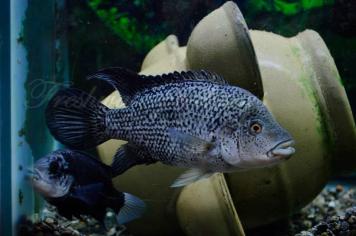

Difficulty: 5/5
Tank minimum: 100 gallon for solo adult
Water parameters: 73F-82F, PH 6.0-7.5
Maximum size: 14″
Tank region: All over
Behavior: Extremely Aggressive
Diet: Omnivore based. Will accept most foods and should include a high quality pellet, as well as a variety of live or frozen foods such as worms, bloodworms, brine, mysis, prawn, mussle. Veggies should be offered either fresh, frozen, or a pellet.
Compatibility: Best kept solo
Extra: The Haitian cichlid also goes by the name “Black Nasty.” This name was no accident as this fish can be quite nasty. They have been known to even attack Dovii and Jaguar cichlid twice their size and can be quite intolerant to tankmates. Every individual can have a different personality, but it’s recommended to keep this fish solo as it’s highly unlikely it will be willing to share a tank with anything other than possibly a mate. It is a fairly hardy species that can acclimate to many water parameters as long as they are not extreme. Use caution when using live plants and consider hardy plants such as Java Fern. Like the beani, this species is prone to bloat which can be caused by a number of things such as improper diet, overfeeding, and stress. For this reason, I would not recommend this species for anyone besides the advance keeper.
Nandopsis Tetracanthus
“Cuban Cichlid”
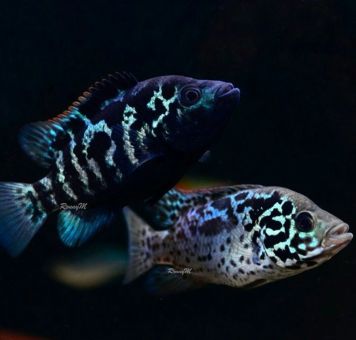
Difficulty: 2/5
Tank minimum: 55 gallon
Water parameters: 75F-85F, PH 7.0-8.0
Maximum size: 10″
Tank region: All over
Behavior: Aggressive
Diet: Will except most foods. High quality pellet or flake, as well as live or frozen foods such as worm, shrimp, mussels, etc.
Compatibility: Other robust cichlids with similar size and temperament.
Extra: This slow growing cichlid is often mistaken for jaguar cichlid as juveniles since they have similar patterns. They great differ in size and attitude though, however. The Cuban’s personality will vary among individuals as some can be quite docile, while others have been known to be downright nasty. As mentioned, this species is a particularly slow grower so keep in mind that it’s tankmates may outgrow it quite quickly. This may be a great option for those who are attracted to the jaguars beautiful markings and looks, but would like a more manageable size fish. This species is known to be quite destructive with live plants.
Parachromis Dovii
“Wolf Cichlid”


Difficulty: 5/5
Tank minimum: 125 gallon for juvenile, 240 gallon for solo adult or single pair.
Water parameters: 75F-82F, PH 6.5-7.8
Maximum size: 24″+
Tank region: All over
Behavior: Extremely Aggressive
Diet: Carnivore based. Will except most foods. High quality pellet or flake, as well as live or frozen foods such as fish, worm, shrimp, mussels, etc.
Compatibility: Best kept solo
Extra: The Dovii, also known as the wolf cichlid, is one of the most aggressive cichlids in the trade. They do best kept solo though some have kept them with tankmates until the Dovii kills everything off. Even though each individual has their own personality, it’s highly unlikely they will work in a cichlid community for long. It’s usually not a matter of “if” and more-so of “when.” They are part of the category of cichlid dubbed “glass bangers” for good reason. These fish can be so aggressive that they have been known to slam the glass in an attempt to attack outside intruders. They have a large bioload so it’s important to have heavy filtration and regular water changes. This species is known to be quite destructive with live plants. One cannot deny the beauty of this fish, however, due to this nasty attitude and enormous size they are recommended to only advanced keepers.
Parachromis Friedrichsthalii
“Freddy”

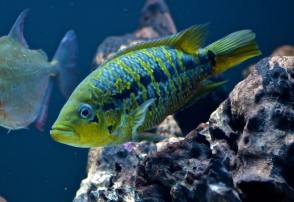
Difficulty: 3/5
Tank minimum: 125 gallon
Water parameters: 75F-82F, PH 7.0-8.0
Maximum size: 12″
Tank region: All over
Behavior: Extremely aggressive
Diet: Carnivore based. Will except most foods. High quality pellet or flake, as well as live or frozen foods such as fish, worm, shrimp, mussels, etc.
Compatibility: Other robust cichlids with similar size and temperament.
Extra: The yellow jacket, or Freddy, is often mistaken for its relative the Loiselle. While it’s difficult to distinguish the two, the Loiselle will have iridescence around the black markings. Freddy tend to have darker markings, while the Loiselle will have a thicker and taller shape. Like most cichlids, it is fairly hardy as long as it’s needs are met. They have a large bioload so it’s important to have heavy filtration and regular water changes. While they can be housed with other robust cichlid, they do require plenty of space as they can be quite aggressive. This species is known to be quite destructive with live plants.
Parachromis Loisellei
“Loisellei”
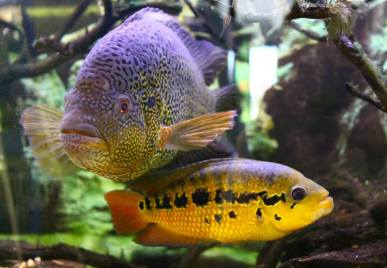
Difficulty: 3/5
Tank minimum: 125 gallon
Water parameters: 75F-82F, PH 7.0-8.0
Maximum size: 12″
Tank region: All over
Behavior: Extremely aggressive
Diet: Carnivore based. Will except most foods. High quality pellet or flake, as well as live or frozen foods such as fish, worm, shrimp, mussels, etc.
Compatibility: Other robust cichlids with similar size and temperament.
Extra: The Loiselle is often mistaken for it’s relative, the Freddy. While it’s difficult to distinguish the two, the Loiselle will have iridescence around the black markings. Freddy tend to have darker markings, while the Loiselle will have a thicker and taller shape. Like most cichlids, it is fairly hardy as long as it’s needs are met. They have a large bioload so it’s important to have heavy filtration and regular water changes. While they can be housed with other robust cichlid, they do require plenty of space as they can be quite aggressive. This species is known to be quite destructive with live plants.
Parachromis Manganese
“Jaguar”



Difficulty: 3/5
Tank minimum: 125 gallon for 1 pair
Water parameters: 75F-82F, PH 7.0-8.0
Maximum size: 16″
Tank region: All over
Behavior: Extremely aggressive
Diet: Carnivore based. Will except most foods. High quality pellet or flake, as well as live or frozen foods such as fish, worm, shrimp, mussels, frogs, etc.
Compatibility: Other robust cichlids with similar size and temperament. Recommended to keep solo.
Extra: The Jaguar is the most commonly available of the Parachromis family, but it’s striking markings are far from common. As juvenile the jag is quite dull, but as it grows larger it’s “jaguar type” pattern will slowly emerge. The females will be rounder and shorter bodied, with a more yellow color to them. While the male will get larger, leaner, and have black finds and a more brilliant pattern. The color does vary between species depending on their catch point, as some may have a bluish hue, yellow hue, or purple one. This fish is not a good choice for beginners as it can be extremely aggressive. Many jags are fairly even tempered until they hit around the 10″ mark and then suddenly become too much for some of their owners. Since many fish stores will not take back such a large, aggressive fish; it is not recommended to take on such a fish unless you have reasonable accommodations for a full grown jag. Like most cichlids, it is fairly hardy as long as it’s needs are met. They have a large bioload so it’s important to have heavy filtration and regular water changes. While they can be housed with other robust cichlid, they do require plenty of space as they can be quite aggressive. This species is known to be quite destructive with live plants.
Parachromis Motaguense
“Red Tiger”
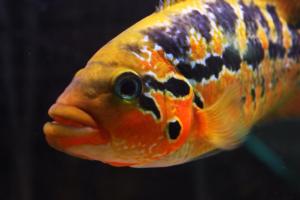
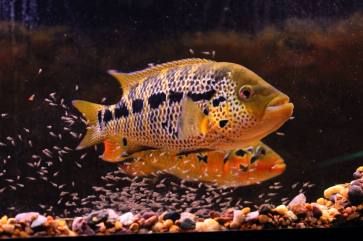
Difficulty: 3/5
Tank minimum: 75 gallon for single pair
Water parameters: 75F-82F, PH 7.0-8.0
Maximum size: 12″
Tank region: All over
Behavior: Extremely aggressive
Diet: Carnivore based. Will except most foods. High quality pellet or flake, as well as live or frozen foods such as fish, worm, shrimp, mussels, etc.
Compatibility: Other robust cichlids with similar size and temperament.
Extra: The Red Tiger is a brilliant species in the Parachromis family. The females may stay slightly smaller than the male, but will have bold red markings, particularly around breeding time. The males will have distinct freckles throughout the body, making them attractive in their own right. While they may stay smaller than the Jaguar, some may argue that they have just as much attitude. Like most cichlids, it is fairly hardy as long as it’s needs are met. They have a large bioload so it’s important to have heavy filtration and regular water changes. While they can be housed with other robust cichlid, they do require plenty of space as they can be quite aggressive. This species is known to be quite destructive with live plants.
Paratheraps Bifasciatus
“Bifa”

Difficulty: 3/5
Tank minimum: 75 gallon for single adult
Water parameters: 75F-80F, PH 7.0-8.0
Maximum size: 14″
Tank region: All Over
Behavior: Aggressive
Diet: Herbivore based diet. Will accept high quality pellet or flake. Include variety of live and frozen foods such as worms, white fish,shrimp, mussles, as well as fresh veggies.
Compatibility: Other robust cichlids with similar size and temperament.
Extra: This large cichlid is a great option for cichlid keepers looking to add color to their collection. While this species isn’t overly aggressive, it can become a bully if housed with fish that can be timid. Similar in appearance to the synspilum, the bifa can be distiguished with more oranges and reds. Like most cichlids, it is fairly hardy as long as it’s needs are met. They have a large bioload so it’s important to have heavy filtration and regular water changes. While they can be housed with other robust cichlid, they do require plenty of space as they can be quite aggressive. This species is known to be quite destructive with live plants.
Paratheraps Hartwegi
“Hartwegi”

Difficulty: 2/5
Tank minimum: 120 gallon
Water parameters: 75F-82F, PH 7.0-7.6
Maximum size: 12″
Tank region: All over
Behavior: Aggressive, particularly conspecific
Diet: Omnivore based with vegetables included. Will except most foods. High quality pellet or flake, as well as live or frozen foods such as worm, shrimp, mussels, etc.
Compatibility: Other robust cichlids with similar size and temperament.
Extra: The hartwegi, also known as the red freckle cichlid, is a relatively uncommon fish in the trade. While not as vibrant as some of it’s relatives, it has fairly striking markings such as those trademark red freckles. Like most cichlids, it is fairly hardy as long as it’s needs are met. They have a large bioload so it’s important to have heavy filtration and regular water changes. This species is known to be quite destructive with live plants.
Paratheraps Synspilus
“Red Head”

Difficulty: 3/5
Tank minimum: 75 for single pair
Water parameters: 76F-82F, PH 6.8-7.8
Maximum size: 13″
Tank region: All over
Behavior: Moderately aggressive, conspecific aggressive
Diet: Herbivore based. Will accept high quality pellet or flake. Include variety of live and frozen foods such as worms, white fish,shrimp, mussles, as well as fresh veggies, spirulina, and/or algae wafers.
Compatibility: Successful in a community of large, robust cichlids.
Extra: The Synspilum, or Red Head, is one of the most colorful American Cichlids in the hobby. It is one of the more peaceful of the Vieja/Paratheraps species making it a great choice for intermediate cichlid keepers. Usually only moderately aggressive, it can hold it’s own fairly well alongside more aggressive species; though every individual’s personality will vary. Like most cichlids, it is fairly hardy as long as it’s needs are met, though they do need extremely clean water in order to thrive. They have a large bioload so it’s important to have heavy filtration and regular weekly water changes. This species is known to be quite destructive with live plants.
Rocio Octofasciata
“Jack Dempsey”

Difficulty: 2/5
Tank minimum: 55 gallon
Water parameters: 75F-85F, PH 6.5-8.0
Maximum size: 10″
Tank region: All over
Behavior: Aggressive
Diet: Omnivore based. Will except most foods. High quality pellet or flake, as well as live or frozen foods such as worm, shrimp, mussels, etc.
Compatibility: Other robust cichlids with similar size and temperament.
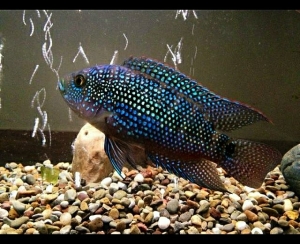
Extra: The Jack Dempsey is a very popular fish in the trade and a great choice for beginners looking to start a cichlid tank. I find this fish extremely under-appreciated due to how common it is as it’s actually a very attractive fish. The jack dempsey is an extremely hardy and forgiving species and will usually acclimate to many water parameters as long as they aren’t too extreme. They are also fairly versatile and can be kept with medium sized cichlids or be able to hold it’s own with larger more aggressive fish. They have a wide range of personalities so some Jack may be fairly mild mannered, while another can be downright nasty. I usually prefer to raise a group of juveniles together until I figure out which personality works best in my tank. This species is known to be quite destructive with live plants.
Vieja Argentea
“Silver Cichlid”


Difficulty: 3/5
Tank minimum: 75 gallon long for a full grown single fish
Water parameters: 75F-85F, PH 7.0-7.8
Maximum size: 12″
Tank region: All over
Behavior: Aggressive, especially con-specific.
Diet: Herbivore based diet. Will accept high quality pellet or flake. Include variety of live and frozen foods such as worms, white fish,shrimp, mussles, as well as fresh veggies.
Compatibility: Other robust cichlids with similar size and temperament.
Extra: Also known as the Silver Cichlid, the Argentea is a stunning addition to any large cichlid community. What this fish lacks in color is made up by it’s striking beauty. Like most cichlids, it is fairly hardy as long as it’s needs are met. They have a large bioload so it’s important to have heavy filtration and regular water changes. While they can be housed with other robust cichlid, they do require plenty of space as they can be quite aggressive. This species is known to be quite destructive with live plants.
Vieja Maculicauda
“Black Belt”
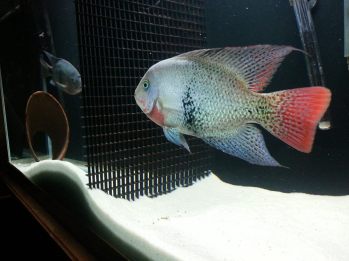

Difficulty: 3/5
Tank minimum: 75 gallon for single adult
Water parameters: 73F-82F, PH 6.5-8.0
Maximum size: 12″
Tank region: All over
Behavior: Aggressive, especially conspecific
Diet: Herbivore based diet. Will accept high quality pellet or flake. Include variety of live and frozen foods such as worms, white fish,shrimp, mussles, as well as fresh veggies.
Compatibility: Other robust cichlids with similar size and temperament.
Extra: What this fish lacks in color is made up by it’s striking beauty. Like most cichlids, it is fairly hardy as long as it’s needs are met. They have a large bioload so it’s important to have heavy filtration and regular water changes. While they can be housed with other robust cichlid, they do require plenty of space as they can be quite aggressive. This species is known to be quite destructive with live plants.
Cichlid, Other
Hemichromis Guttatus “Jewel Cichlid”
Buttikoferi Tilapia “Zebra Tilapia”
Paratilapia Polleni “Madagascar”
Hemichromis Guttatus
“Jewel”
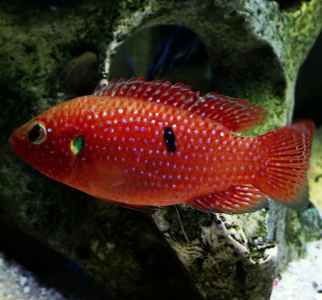
Difficulty: 2/5
Tank minimum: 30 gallons for pair
Water parameters: 70F-79F, PH 6.8-7.5
Maximum size: 5.5″
Tank region: All over
Behavior: Aggressive
Diet: Omnivore based. Will accept most foods and should include a high quality pellet, as well as a variety of live or frozen foods such as worms, bloodworms, spirulina, brine, mysis, prawn, mussle.
Compatibility: Other larger cichlids with similar requirements, or with a large, fast moving dither school. Best kept as a solo pair
Extra: While the Jewel is an African cichlid, it is from the rivers instead of the lakes. Therefore, it’s requirements are much different than those of the rift lakes. Their needs are closer to the American cichlids than the African. Due to their aggressive nature, tankmates can be tricky. They can take on much larger fish than themselves and can get themselves into some trouble with their attitude. While it can be done, I recommend keeping these as a species specific tank.
Buttikoferi Tilapia
“Zebra Tilapia”
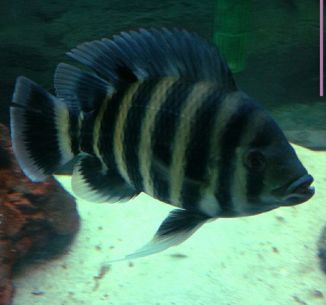
Difficulty: 2/5
Tank minimum: 80 gallon for solo adult
Water parameters: 73F-79F, PH 6.5-7.8
Maximum size: 18″
Tank region: All over
Behavior: Extremely Aggressive
Diet: Omnivore based. Will accept most foods and should include a high quality pellet, as well as a variety of live or frozen foods such as worms, bloodworms, spirulina, brine, mysis, prawn, mussle.
Compatibility: Best kept solo!
Extra: The Buttikoferi has the reputation for being one of the most aggressive fish in the freshwater hobby. “Satan in Scales” “Demon Fish” “Glass Banger” are just a few of the many nicknames this fish has gotten from other hobbyists. This fish is very intelligent and could make for an interesting choice anyone looking to keep an interactive pet…though the interaction may not be the friendliest. With it’s large size and big personality, it makes for an impressive fish. 80 gallons is the absolute minimum keeping a full grown Butti, though realistically they need at least 120 gallons or more to themselves.
Paratilapia Polleni
“Madagascar”
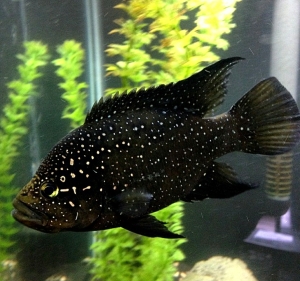
Difficulty: 3/5
Tank minimum: 75 gallon
Water parameters: 79F-82F, PH 7.0-8.5, GH Soft
Maximum size: 10″
Tank region: All over
Behavior: Mildly Aggressive
Diet: Omnivore based. Will accept most foods and should include a high quality pellet, as well as a variety of live or frozen foods such as worms, bloodworms, spirulina, brine, mysis, prawn, mussle.
Compatibility: Other larger cichlids with similar needs and temperament
Extra: The Polleni is an unusual cichlid from Madagascar that still has a lot unknown about it. More common than it’s relative, the Bleekeri, it can be distinguished by it’s smaller spots. Though there is much to be learned still about this fish, some people have had success keeping this fish with larger American cichlids that are more mild tempered. Some have kept them with community fish with bottom dwellers and larger schooling as well. Though they are technically African, they may not thrive well in many African communities. Stay tuned on further information on this mysterious fish.
Datnoid
Datnioides microlepis
Difficulty: 5/5
Tank minimum: 100 gallon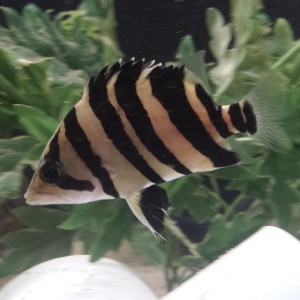
Water parameters: 71F-81F, PH 6.5-7.5
Maximum size: 16″
Tank region: All over
Behavior: Predatory, Conspecific Aggressive
Diet: Carnivore based. Can be picky but will accept meaty foods such as live fish, blackworms, bloodworms, shrimp, crustaceans, etc. Can possibly be pellet trained.
Compatibility: Other large bodied fish. Avoid overly aggressive tankmates and smaller fish that can eaten.
Extra: The Indo Datnoid is the most commonly available Datnoid available in the fish hobby. This oddball is inquisitive and is considered part of the “Wet Pet” category of fish. The “Wet Pet” type fish are those fish that have been known to be very observant and interactive with their owners. The Indo can reach upwards of 17″ but is typically closer to 9″-12″ in captivity and is a very slow grower. 100 gallons is the absolute minimum for an adult datnoid, though larger is always better. They are relatively peaceful among larger tankmates, but will usually stick up for themselves if need be. Anything that the dat thinks can be food is in danger when kept with this fish. Despite it’s mouth looking fairly small, it can extend quite large. While some people keep more than one datnoid together, they have been known to be bullies with one another. Words like “stable” is used when referring to datnoids which describes the state the datnoid is in. A datnoid with bold bars, is eating, and is active is a stable fish. A datnoid that is mottled, dark with it’s bars faded is a sign of a stressed out, unstable fish. Many people have had their datnoids mysteriously die, making them a choice best kept to more experienced keepers. While they can be pellet trained, expect to be feeding frozen or live food as they can be quite stubborn to train onto pellets.
Eel
Fire Eel
Tiretrack Eel
Zigzag Eel
←Back
Fire Eel
Mastacembelus erythrotaenia
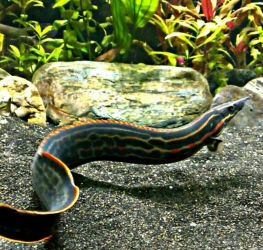

Difficulty: 3/5
Tank minimum: 180 gallon
Water parameters: 75F-82F, PH 6.5-7.5
Maximum size: 40″
Tank region: Bottom dwelling
Behavior: Predatory, conspecific aggressive
Diet: Carnivore based. Can be picky but will accept meaty foods such as blackworms, bloodworms, nightcrawlers, shrimp, mussels, crustaceans, etc. Can be pellet trained.
Compatibility: Other large bodied fish. Avoid overly aggressive tankmates and smaller fish that can eaten.
Extra: The Fire Eel is a large spiny eel, though not a true eel, that is moderate to intermediate with it’s care. While it is relatively peaceful, especially as a juvenile they can be aggressive with other fire eels, as well as other spiny eel species. As juveniles they can be housed in a 55 gallon, but will require at least 180 gallons when full grown. While they can reach up to 40″ in the wild, they usually reach closer to 20″-24″ in captivity, which they can reach fairly quickly with optimal care. This fish can be sensitive to poor water conditions so regular weekly water changes are a necessity and a secure lid is an absolute must as these fish can be escape artists. And a soft substrate such as sand is an excellent choice when keeping spiny eels as a sharp gravel can injure their delicate bellies. Use caution when keeping this species with plants as they can become unrooted. Like other scaleless fish, this species can be quite sensitive to medications.
Tiretrack Eel
Mastacembelus favus
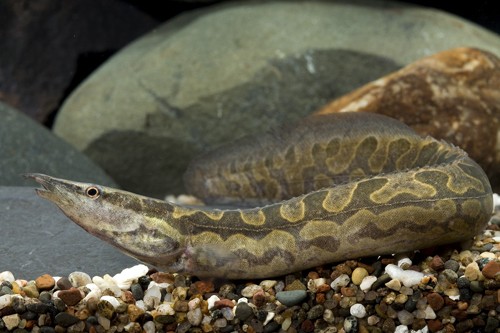
Difficulty: 3/5
Tank minimum: 125 gallon
Water parameters: 72F-82F, PH 6.8-7.8
Maximum size: 28″
Tank region: Bottom dwelling
Behavior: Predatory, conspecific aggressive
Diet: Carnivore based. Can be picky but will accept meaty foods such as blackworms, bloodworms, nightcrawlers, shrimp, mussels, crustaceans, etc. Can sometimes be pellet trained.
Compatibility: Other large bodied fish. Avoid overly aggressive tankmates and smaller fish that can eaten.
Extra: The Tire Track eel is spiny eel, though not a true eel, that is often mistaken with the Zig Zag. The Tire Track will be smaller than the Zig Zag, which will get larger at around 36″. The Zig Zag will have markings that are the most bold on the upper two thirds of its body and it’s belly will have no markings. The Tire Track, on the other hand, will have markings throughout it’s body, as well as on it’s belly. This fish can be sensitive to poor water conditions so regular weekly water changes are a necessity and a secure lid is an absolute must as these fish can be escape artists. And a soft substrate such as sand is an excellent choice when keeping spiny eels as a sharp gravel can injure their delicate bellies. Use caution when keeping this species with plants as they can become unrooted. Like other scaleless fish, this species can be quite sensitive to medications.
Zigzag Eel
Mastacembelus armatus
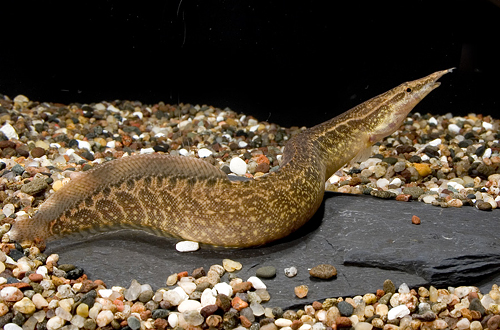
Difficulty: 3/5
Tank minimum: 125 gallon
Water parameters: 72F-82F, PH 6.8-7.8
Maximum size: 36“
Tank region: Bottom dwelling
Behavior: Predatory, conspecific aggressive
Diet: Carnivore based. Can be picky but will accept meaty foods such as blackworms, bloodworms, nightcrawlers, shrimp, mussels, crustaceans, etc. Can sometimes be pellet trained.
Compatibility: Other large bodied fish. Avoid overly aggressive tankmates and smaller fish that can eaten.
Extra: The Zig Zag Eel, though not a true eel, is often mistaken for the Tire Track. The Tire Track will be smaller than the Zig Zag, which will get larger at around 36″. The Zig Zag will have markings that are the most bold on the upper two thirds of its body and it’s belly will have no markings. The Tire Track, on the other hand, will have markings throughout it’s body, as well as on it’s belly. This fish can be sensitive to poor water conditions so regular weekly water changes are a necessity and a secure lid is an absolute must as these fish can be escape artists. And a soft substrate such as sand is an excellent choice when keeping spiny eels as a sharp gravel can injure their delicate bellies. Use caution when keeping this species with plants as they can become uprooted. Like other scaleless fish, this species can be quite sensitive to medications.
Gar
Florida Spotted Gar
Alligator Gar
Florida Spotted Gar
Lepisosteus platyrhincus
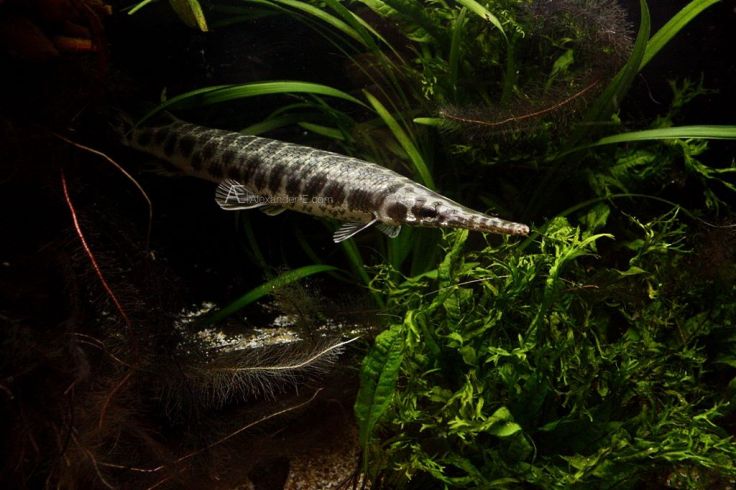
Difficulty: 3/5
Tank minimum: 200 gallon long “breeder”
Water parameters: 70F-84F, PH 6.5-7.8
Maximum size: 60″
Tank region: All over, Mostly middle
Behavior: Predatory, though generally mild mannered
Diet: Carnivore/Piscivore based. Most will only eat live fish at first. Will accept meaty foods such as shrimp, prawn, crickets, silversides, krill, etc.
Compatibility: : Other large bodied fish. Avoid overly aggressive tankmates that can out compete with food and smaller fish that can eaten.
Extra: The Florida Spotted Gar is very similar in appearance to the Spotted Gar, though it is the more readily available species of the two. This large fish is actually quite peaceful as long as it’s tankmates are not too small for the gar to think they are food. It is important that this fish is kept in a large enough tank to accommodate it’s size and it wide enough to allow the gar to turn around because they are at risk of breaking their backs. The size of the Florida Spotted varies greatly, but they are usually around 34″. This means they will require closer to 300-450 gallons when full grown and it’s important that the tank is a breeder type tank (long and shallow vs. tall and deep.) Avoid housing with fast swimming fish that can out compete the gar with food.
Alligator Gar
Atractosteus spatula
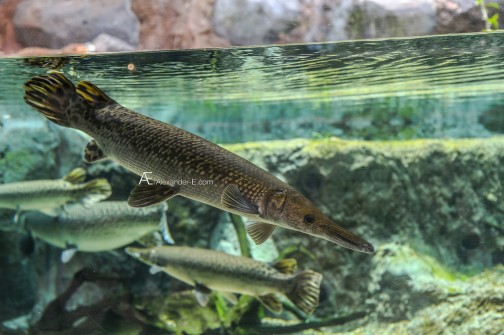
Difficulty: 5/5
Tank minimum: 1,500 gallons+Not appropriate for aquariums
Water parameters: 70F-80F, PH 6.5-7.5
Maximum size: 120″ that’s 10 feet!
Tank region: All over, mostly middle
Behavior: Predatory
Diet: Carnivore/Piscivore based. Most will only eat live fish at first. Will accept meaty foods such as shrimp, prawn, crickets, silversides, krill, etc.
Compatibility: Other large bodied fish. Avoid overly aggressive tankmates that can out compete with food and smaller fish that can eaten.
Extra: The Alligator Gar is a largest of the gar species and is best suited for public aquariums who can house this 300 lb fish or someone with a very large pond. As juveniles it is important that they are fed meaty foods daily to keep up with their fast metabolisms, but as they get larger they need to eat less often. They are fairly easy to keep as long as they are housed properly and their requirements are met and do best in neutral waters with nothing too extreme.
Payara
Armatus Payara
Hydrolycus Armatus
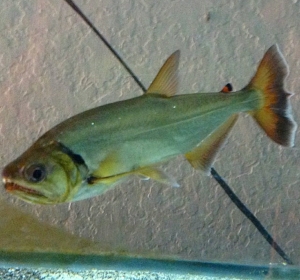

Difficulty: 5/5
Tank minimum: 500 gallon
Water parameters: 75F-82F, PH 6.0-8.0
Maximum size: 36″
Tank region: Middle-bottom dwelling
Behavior: Predatory
Diet: Carnivore/Piscivore based. Meaty foods with majority of diet consisting of fish such as silversides, smelt, mackerel. Possibly river shrimp or worms
Compatibility: Best kept solo, can be kept with stingrays, mbu puffer, large fish that won’t fit in it’s mouth.
Extra: The Armatus is the largest of the payara species and can grow fairly large. Recommended for experts only. Due to the difficulty of keeping this fish, many have only had success in keeping this fish alive for a year or two never allowing this fish to reach full size. The Armatus is less common, more expensive, and a tad hardier than the Scomb, however. The Armatus needs to be kept as a single species, and the scomb can be kept in groups. 200 gallon or larger seems to be the tank minimum for keeping these fish as juvenile, 500 is more realistic for adults, but closer to 1000 gallons is much more ideal in order to truly reach it’s potential and live longer. These fish require a heavy current and pristine water conditions are an absolute must. Avoid nocturnal tankmates that can spook this fish. This species is very sensitive to medications.
Scomb Payara
Hydrolycus Scomberoides
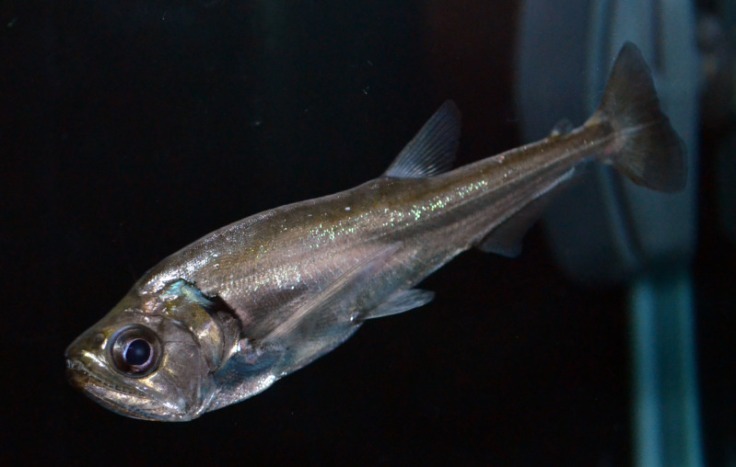
Difficulty: 5/5
Tank minimum: 200 gallon
Water parameters: 75F-82F, PH 6.0-8.0
Maximum size: 12″
Tank region: Middle
Behavior: Predatory, skittish
Diet: Carnivore/Piscivore based. Meaty foods with majority of diet consisting of fish such as silversides, smelt, mackerel. Possibly river shrimp or worms
Compatibility: Similar size tank mates. Can be kept in groups, avoid overactive species.
Extra: The Scomb, or Vampire Tetra, is one of the more commonly available payara. They are less expensive, a little less aggressive, and can be kept in a group. However, they tend to be more delicate and are notorious for dying within a year or two. They are slow growers so care should be given when choosing tank mates as many will outgrow this fish quickly. Avoid fluctuations in temperature and PH, and these fish require a heavy current and pristine water conditions and are an absolute must. Avoid nocturnal tankmates that can spook this fish. This species is extremely sensitive to medications.
Pufferfish
Spotted Puffer
Figure 8 Puffer
Fahaka Puffer
Mbu Puffer
←Back
Green Spotted Puffer
Tetraodon nigroviridis

Difficulty: 3/5
Tank minimum: 30 gallons
Water parameters: 78F-82F, PH 7.5-8.2, Salinity 1.005-1.20
Maximum size: 6″
Tank region: All over
Behavior: Aggressive
Diet: Carnivore based. Frozen/freeze dried/live meaty foods such as krill, ghost shrimp, worms, crickets, prawns, brine, etc. Adults can also have clams, mussels, squid, scallops, shrimp, crab legs, oysters, lobsters, crayfish. Snails are a must, especially juveniles.
Compatibility: Use caution with tankmates. Other brackish or saltwater fish such as monos, scat, archerfish may work.
Extra: Often sold in the freshwater section, the Green Spotted Puffer is not a true freshwater fish. While they may start as juvenile in freshwater, they require brackish-saltwater in order to survive. By keeping this freshwater long term, you will drastically shorten their lifespans and some may only live up to 3 years, though sometimes much, much shorter. In reality this fish is meant to live closer to 10 years, sometimes even 15 years. Many uninformed hobbyists with argue that they can be kept freshwater, but the reality is that this is an inappropriate choice for freshwater keepers.
The GSP, like all puffers, is full of personality and can entertain for hours, but with all that adorable comes a dark side. Puffers are known for being quite nasty and biting or killing it’s tank mates. Having a larger aquarium will reduce the chances of aggression. Meaty foods with a hard shell, such as snails are a requirement when keeping most puffers. Like rodents, their teeth will continue to grow so it is important that they are kept under control with foods like snails to keep them filed down.
Figure 8 Puffer
Tetraodon biocellatus

Difficulty: 3/5
Tank minimum: 15 gallon for single fish
Water parameters: 78F-82F, PH 7.5-8.2, Salinity 1.005-1.008
Maximum size: 4″
Tank region: All over
Behavior: Aggressive
Diet: Carnivore based. Frozen/freeze dried/live meaty foods such as krill, ghost shrimp, worms, crickets, prawns, brine, etc.
Compatibility: Use caution with tankmates. Other brackish fish such as monos, scat, archerfish, mollies, bumblebee goby, knight gobies may work.
Extra: The Figure Eight Puffer is another brackish fish often sold in the freshwater section. While they may start as juvenile in freshwater, they require brackish-saltwater in order to survive. By keeping this freshwater long term, you will drastically shorten their lifespans. Many uninformed hobbyists with argue that they can be kept freshwater, but the reality is that this is an inappropriate choice for freshwater keepers. They can get up to 4″ in size, but are realistically closer to 2.5″-3″. A single fish can be kept in 15 gallons (though 30 gallons is a little more ideal) and 10 gallons per additional Figure Eight after.
Like all puffers, the Figure Eight is full of personality and can entertain for hours, but with all that adorable comes a dark side. Puffers are known for being quite nasty and biting or killing it’s tank mates. Having a larger aquarium will reduce the chances of aggression. Meaty foods with a hard shell, such as snails are a requirement when keeping most puffers. Like rodents, their teeth will continue to grow so it is important that they are kept under control with foods like snails to keep them filed down.
Fahaka Puffer
Tetraodon lineatus


Difficulty: 4/5
Tank minimum:125gallon
Water parameters: 75F-82F, PH 6.5-7.5
Maximum size: 18″
Tank region: All over, mostly middle-bottom dwelling
Behavior: Aggressive
Diet: Carnivore based. Frozen/freeze dried/live meaty foods such as krill, ghost shrimp, worms, crickets, prawns, brine, etc. Adults can also have clams, mussels, squid, scallops, shrimp, crab legs, oysters, lobsters, crayfish. Snails are a must, especially juveniles.
Compatibility: Best kept solo
Extra: The Fahaka Puffer is a large freshwater puffer that is kept to more experienced keepers. While they may tolerate a small amount of salinity, they do best in freshwater. Like all puffers, the Fahaka is full of personality and can be trained to eat out of your hand, but with all that adorable comes a dark side. Puffers are known for being quite nasty and biting or killing it’s tank mates, therefore it is highly recommended to keep this fish solo. Meaty foods with a hard shell, such as snails are a requirement when keeping most puffers. Like rodents, their teeth will continue to grow so it is important that they are kept under control with foods like snails to keep them filed down. Heavy filtration is a must as these fish are messy, have a high bioload, and are very sensitive to nitrates and ammonia.
Mbu Puffer
Tetraodon mbu

Difficulty: 5/5
Tank minimum: 300 gallons+
Water parameters: 75F-82F, PH 7.0-8.0, GH hard
Maximum size: 30″
Tank region: All over, mostly middle-bottom dwelling
Behavior: Very aggressive
Diet: Carnivore based. Frozen/freeze dried/live meaty foods such as krill, ghost shrimp, worms, crickets, prawns, brine, etc. Adults can also have clams, mussels, squid, scallops, shrimp, crab legs, oysters, lobsters, crayfish. Snails are a must, especially juveniles.
Compatibility: Best kept solo
Extra: The Mbu Puffer is the largest of all the freshwater puffer species and is recommended to only experienced keepers. While this fish can tolerate smaller tanks as a juvenile, they will eventually need 1000 gallons when full grown. Like all puffers, the Mbu is full of personality and can be trained to eat out of your hand (though use extreme caution), but with all that adorable comes a dark side. Puffers are known for being quite nasty and biting or killing it’s tank mates, therefore it is highly recommended to keep this fish solo. Meaty foods with a hard shell, such as snails are a requirement when keeping most puffers. Like rodents, their teeth will continue to grow so it is important that they are kept under control with foods like snails to keep them filed down. Heavy filtration is a must as these fish are messy, have a high bioload, and are very sensitive to nitrates and ammonia.
African Tiger Fish
Hydrocynus vittatus
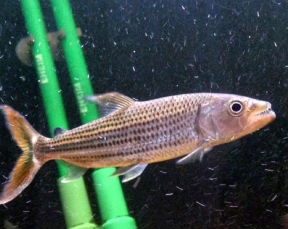
Difficulty: 5/5
Tank minimum: 650 gallon
Water parameters: 72F-82F, PH 6.5-8.0
Maximum size: 41″
Tank region: All over, mostly middle-bottom dwelling
Behavior: Predatory
Diet: Carnivore/Piscivore based. Will eat mostly live fish but can be trained onto frozen meaty foods such as shrimp, whole fish, smelt, silversides. Possibly can be pellet trained, though difficult.
Compatibility: tankmates must be much larger. Juveniles have been known to school together, adults solo.
Extra: There are a few different species of Tiger Fish, though for now I am only starting with the African Tiger. Though not as large as the Goliath Tiger Fish, this species still gets fairly large. They can get upwards of 42″ but are usually seen closer to 30″ in captivity. They are fairly hardy, though housing them can be quite difficult. They can be housed in a minimum of 650 gallons, but 1000 gallons is more ideal. They need heavy filtration, a strong current, and heavily oxygenated water.



